EXHAUSTING


Chief medical officer Professor Chris Whitty calls for action on air pollution





Parking Review and EVolution will be bringing you news and analysis throughout 2023


A New Year’s resolution: Publish great magazines and produce expert, even entertaining gatherings for the parking family
Happy New Year! January is a time to make resolutions, which on an individual level usually involves a list of ways of things that make for a happier life, such as healthier eating, drinking less, not working weekends and making more time for friends and family. It usually takes less than a month for most of these ambitions to fall by the wayside. On a professional level, the need to create schedules and features lists means there are structures that mean, as in normal years, what is planned in January has, by and large, been achieved by the time next year’s timetable needs to be signed off.
However, it has been a little while since we have had a normal year. For a couple of years the pandemic played havoc with work schedules, especially with regard to live events. While COVID is still a fact of life, the efficacy of vaccines and public health interventions have enabled a return to something resembling everyday life. Despite this, it must be admitted that 2023 has started in a somewhat stuttering fashion due to the current cycle of strikes and economic uncertainties associated with the cost of living crisis and ongoing war in Ukraine. Winter is a dark time, but the best approach is to work on the basis that things will better as the days lengthen and warm up (though too mild weather at the gateway to the year is maybe a cause for concern).
Setting worries about the premature blossoming of flowers aside, it is in a spirit of optimism that I am pleased to usher in 2023 by presenting you with January’s Parking Review and the latest edition of its sister title, EVolution. Over the next 12 months, both magazines and their websites will continue to report on the latest developments in what are fast developing, and closely connected, policy and business sectors. In writing and editing both journals, I am struck by the vast range of themes that we cover, including (to name a few) traffic management, digitising services, air quality, decarbonisation, accessibility, active travel, road safety, urban design and rethinking retail.
Meanwhile, I am working with my colleagues at Landor LINKS to deliver a year of engaging, expert and entertaining events including School Streets, Mobility Hubs, The Enforcement Summit, Traffic + Parking and, best of all, the British Parking Awards 2023. And if we get the catering right, maybe I can keep my pledges to eat healthier among my friends in the parking family!
Mark Moran EditorParking Review online: www.parkingreview.co.uk

School Streets effectively address the congestion, road safety and air quality concerns that many schools experience.

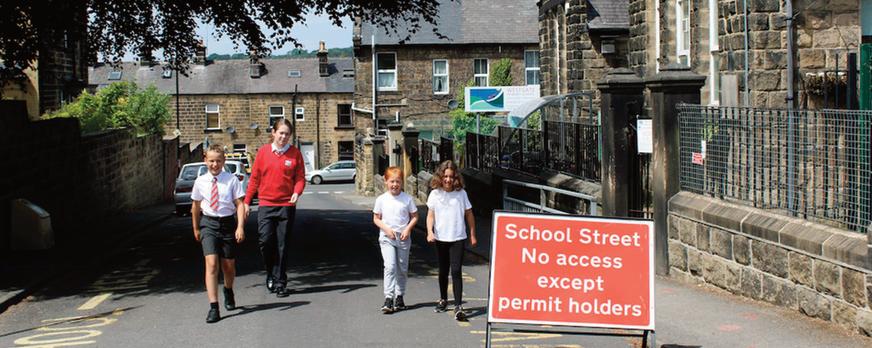
Landor LINKS is running a one-day event, hosted by Lambeth Council, to showcase best practice and offer practical guidance. This inaugural conference will bring together professionals from a range of disciplines.











Editorial Managing editor: Mark Moran



Tel: 020 7091 7871
mark.moran@landor.co.uk
Deputy editor: Deniz Huseyin Tel: 020 7091 7872
deniz.huseyin@landor.co.uk

Editorial director: Peter Stonham
Production and design production@landor.co.uk
Advertising, sponsorship, marketing and exhibition packages
Jason Conboy Tel: 020 7091 7895 jason@landor.co.uk
Subscriptions
Christina Pierre
Tel: 020 7091 7959

subs@landor.co.uk
Accounts
Irina Cocks Tel: 020 7091 7854
irina.cocks@landor.co.uk
Managing Director
Tel: 0191 280 1410

improving active travel reduces air pollution emissions from vehicles and has direct health benefits to those who are walking, wheeling or cycling. In particular, we need to concentrate on the places where people live, work and study; the same air pollution concentration in a densely populated area will lead to greater accumulated health effects than in a sparsely populated area as more people will be affected.
We can and should go further to reduce air pollution, and it is technically possible to do so, says England’s chief medical officer Professor Chris Whitty in his annual report. Whitty focusses on air quality and makes 15 recommendations across a range of sectors, including transport, urban planning, industry and agriculture. This is Whitty’s third report as chief medical officer (CMO). Last year his focus was on health in coastal communities, while the 2020 report looked at health trends and variation in England.
Outdoor air pollution in England has reduced significantly since the 1980s, but it still poses significant health threats including increasing heart disease, stroke, lung disease, cancer and asthma exacerbation. Pollution also leads to increased mortality and is associated with impacts on lung development in children. Whitty also highlights how indoor air pollution is becoming an increasing proportion of the overall problem as outdoor air quality improves.
In his report, Professor Whitty says: “Improvements in engineering for transport and industry, modifications to agricultural practice and improvements in the built environment are examples that should, once a change is made, be self-sustaining and allow us to reap health benefits for the foreseeable future.
“Many of the changes to improve outdoor air pollution have significant co-benefits. For example, reducing the use of fossil fuels for energy reduces both air pollution and carbon emissions;
“The path to better outdoor air quality is clear, and we now need to go down it. Indoor air pollution is becoming an increasing proportion of the problem as improvements in outdoor air pollution occur. Most of our days are spent indoors whether for work, study or leisure, yet indoor air quality has been studied much less than outdoors. While there are some spaces such as owner-occupied houses that are fully private, many indoor spaces are public, including health facilities, schools, other public buildings, and also shops and workplaces. As with outdoor spaces, people in public buildings are exposed to air pollution but can do little about it, so society needs to act. A better understanding of how we can prevent and reduce indoor air pollution should now be a priority.”
The recommendations on outdoor air pollution highlight:

• accelerating the electrification of light vehicles and public transport
• innovation to reduce air pollution from non-exhaust sources such as tyres, and the need for a greater range of options for reducing air pollution from heavy and specialised vehicles
• local urban planning should support reducing air pollution locally – such as near schools and healthcare settings
• in agriculture, ammonia air pollution emissions could be reduced through modified farming practices, such as applying slurry directly to soil
• the NHS has committed to halving its contribution to poor air quality within a decade
Professor Chris Whitty, England’s chief medical officer, says the path to reducing outdoor pollution is clear, but more work is needed on indoor air quality
Sarah Woolnough, chief executive of Asthma + Lung UK: “The report by the chief medical officer (CMO) should act as a rallying call to tackle air pollution. From our very first breath, air pollution has a significant impact on our health. Toxic air not only puts people at risk of potentially life-threatening asthma attacks and dangerous COPD (chronic obstructive pulmonary disease) flare-ups, it can also lead to the development of lung conditions including lung cancer. Chris Whitty is right to highlight the devastating impacts of air pollution and it is now vital that meaningful steps are taken to protect public health from this invisible threat. This includes schemes that work to get the most polluting vehicles off our roads.”
Dr Charmaine Griffiths, chief executive of the British Heart Foundation: “We’re pleased to see the CMO focussing on air pollution in his annual report this year. Research the British Heart Foundation has funded has helped to show just how damaging air pollution can be to our cardiovascular health. We have the tools and understanding to make better air quality a reality, but we need to do more. Making sure this report’s recommendations are implemented will help to clean up the air in all our communities and deliver real improvements to the nation’s health.”
Michelle Mitchell, Cancer Research UK’s chief executive: “We welcome the CMO putting air pollution in the spotlight with this report. Although smoking remains by far the biggest cause of cancer in the UK, air pollution increases the risk of lung cancer in both people with and without a history of smoking –causing almost 1 in ten lung cancer cases in the UK. With more ambition and a willingness to tackle air pollution head on, we know that this can be different. Air pollution is one of the biggest environmental threats to health in the UK, and although substantial progress has been made to reduce harmful levels of pollutants, more needs to be done. The adoption of national and local strategies will be vital in reducing indoor and outdoor air pollution across the country. But that has to start with the UK government making a bold long-term commitment to a reduction in air pollution.”
Dr Sarah Clarke, president of the Royal College of Physicians (RCP), said: “Air pollution is a growing and significant public health challenge and we strongly welcome the chief medical officer making this the focus of his annual report for 2022. The RCP has been highlighting the harmful impacts of air pollution on health since 2016, when we published our report Every Breath We Take with the Royal College of Paediatrics and Child Health. We estimated then that around 40,000 deaths were attributable to outdoor air pollution, and since then a coroner found it to be a cause of death for the first time, that of 9-yearold Ella Adoo Kissi Debrah.”
Professor Chris Whitty is chief medical officer (CMO) for England. He represents the UK on the Executive Board of the World Health Organization.

He is a practising NHS consultant physician at University College London Hospitals (UCLH) and the Hospital for Tropical Diseases, and a visiting professor at Gresham College.
Whitty was the chief scientific adviser for the Department of Health and Social Care from January 2016 to August 2021. He was the interim Government Chief Scientific Adviser from 2017 to 2018, including during the Novichok poisonings. Before that, he was the chief scientific adviser at the Department for International Development (DFID), which included leading technical work on the West Africa Ebola outbreak.
Whitty was appointed as an expert adviser to Active Travel England on 22 October 2022.

Road vehicles have been sources of some of the most important air pollutants, especially PM2.5 and NO2, which are of health concern, particularly in urban areas where there is large population exposure. NO2 is a gas that is produced along with nitric oxide (NO) by combustion processes, and together they are often referred to as nitrogen oxides (NOx). There have been considerable reductions in road vehicle emissions, as successive tightening of regulations on Euro engineering standards for road vehicles have been met.
Tailpipe emissions from petrol and diesel engines are now much lower than they were two decades ago, and they are expected to fall further as zero tailpipe emission electric vehicles are adopted. Maintaining or accelerating this switch is important for air pollution. PM2.5 emissions from brakes are also likely to fall, but not to zero, as the regenerative braking in electric vehicles takes over. This will leave tyre wear emissions and resuspension of road dust – novel low-emission tyre materials – and methods for capturing these particles, without reducing road safety, will become increasingly important.
The move to electric vehicles will take longer for heavy goods vehicles and may provide a need for other engineering solutions, and there may be some interim solutions. Some specific vehicle types are also considered, for example refrigerated vehicles can currently emit significant air pollution from diesel refrigeration units.
For all vehicle types, government action can have a significant impact on air pollution. Central and local government can both change local air pollution, including through regulation and the purchasing of cleaner vehicles for public transport, and the effect on NOx can be substantial.

Clean air zones are, if well designed, potentially a way of reducing tailpipe air pollution, although they can have a mixed reception from the public. Clean air zones are designated in areas with high air pollution concentrations and high population density, and mainly target older vehicles with higher tailpipe emissions in areas of high risk and population vulnerability.
Urban planning can have a major impact on how much people use active forms of transport, compared to transport that emits air pollution. It can also influence the concentration of pollutants in areas of high building density and the impact of urban greening. Active travel, walking, wheeling and cycling has fallen a long way since the 1950s. Reversing this decline would have substantial additional health benefits due to physical activity being built into the normal day, in addition to reductions in air pollution. Improving the infrastructure for active travel is a necessary, although not sufficient, step towards more active trips taken safely by all ages.
UK national average NOx roadside concentration apportioned by source of NOx emissions, 2020
People who feel unsafe or at risk on Oxfordshire’s streets can now get help from the county’s parking patrol officers.
Oxfordshire County Council’s parking contractor Conduent Transportation is training its onstreet parking civil enforcement officers to become the first in the country to participate in the ‘Ask for Angela’ campaign to help vulnerable members of the public in dangerous or uncomfortable situations.
It is an extension of the Ask for Angela campaign that started in 2016 and is used by bars and other venues in the hospitality industry to protect people from sexual or violent assault. Anyone who feels unsafe, vulnerable or threatened can discreetly seek help by approaching staff and asking for Angela.
Cllr Jenny Hannaby, Oxfordshire’s cabinet member for community services and safety, said: “This is an incredibly worthwhile initiative, and we are delighted to be trialling it first in Oxfordshire. Conduent and its officers are pioneering a new approach which we hope will make our streets safer for everyone.”
Jade Neville, head of user experience at Conduent Transportation, said: “Conduent is proud to be the first on-street
parking provider in the country to join the Ask for Angela campaign and make its contribution to improving safety on the county’s streets.”
The code phrase ‘Angela’ indicates that they require help, and a trained member of staff will look to support them. This might be through reuniting them with a friend, arranging a taxi, or calling security or the police.
Working with Thames Valley Police and Oxfordshire County Council and Oxford City Council’s ODS parking officers, Conduent saw an opportunity to help tackle violence against women, girls` and vulnerable people by expanding the Ask for Angela campaign outside of the hospitality industry.
Thames Valley Police assistant
chief constable Katy BarrowGrint, said: “Protecting vulnerable people is a priority for Thames Valley Police and partnership working is key to achieving this. Whilst we seek to prevent harm from ever taking place, we believe initiatives like this help to make people across Oxfordshire feel safer and prevent criminal activity.”
Cllr Diko Walcott, Oxford City Council cabinet member for safer communities, said: “Oxford City Council has long supported and participated in the Ask for Angela initiative as part of our community safety strategy. It’s great to know that ODS are now including their parking attendants along with those from the county council in the scheme.”
Through the training,
Traffic filters designed to reduce traffic, make bus journeys faster and make walking and cycling safer will be trialled in Oxford after improvement works to Oxford railway station are completed.
The decision was made by the county council’s cabinet at a meeting held on 29 November.
The traffic filters will be implemented under an experimental traffic regulation order (ETRO) for a minimum period of six months. During the trial, the county council will assess the impact of the traffic filters by monitoring traffic levels, bus journey times and air quality as well as review any impacts on individuals and those with protected characteristics.
A second public consultation will run during the first six months of the trial. A long-term decision about the traffic filters will be made towards the end of the trial based on monitoring data collected and feedback from consultation.
The decision follows engagement with more than a 100 local businesses, organisations and community groups, including bus companies, hospitals, schools and universities.
The county council also received 5,700 responses to a public consultation that ran from 5 September to 13 October 2022, with another 485 e-mails from members of the public and organisations. All these responses were analysed by an independent research company and changes to the proposals have been made following feedback from the consultation.
The six traffic filters will be located on St Cross Road, Thames Street, St Clements, Hythe Bridge Street, Marston Ferry Road and Hollow Way. These traffic filters are expected to:
• reduce traffic levels by around 20% across the city inside the ring road and around 35% in the city centre
• enable new and improved bus routes
Conduent’s parking officers have been given an awareness of vulnerability and their responsibilities towards the public during their shifts. The aim is for officers to be an additional point of contact for those who feel unsafe, as Ask for Angela is taken into the wider environment.

Members of the Oxfordshire parking enforcement team receive welfare and vulnerability engagement training from the Safer Business Network, and this will also form part of the new starters’ induction process.
The training is based on real life incidents and is designed to look at what can be done to tackle vulnerability on streets.
Parking enforcement officer
Roberta Santos said: “The training helped me to identify a person in a vulnerable situation, or someone who does not appear comfortable. After this training, I am confident in my ability to help a person in need.”
The scheme will be operating in Oxford city, plus the Vale of White Horse, South Oxfordshire, and Cherwell District Council areas of Oxfordshire. West Oxfordshire will not be included at this stage, as different parking enforcement arrangements are in place until spring 2023.
Conduent is also working with the British Parking Association as sponsors of Women in Parking to support its tackling violence against women and girls campaign, which is backed by the government.
• increase bus and park & ride use by up to 10%
• reduce road accidents by around 34 per year
• reduce annual carbon emissions associated with road transport by 6%
• increase walking and cycling trips by around 10%.
The trial will be implemented after Botley Road reopens to motorised traffic following major improvements to Oxford railway station. This will enable an effective and representative trial to take place. The road is due to close to through traffic on 9 January 2023 and is expected to reopen after 12 months.
The council’s cabinet also approved the Central Oxfordshire Travel Plan, which outlines 22 actions to help achieve a sustainable and reliable net zero transport system across Oxford and the surrounding areas of Kidlington, Eynsham, Botley, Cumnor, Kennington and Wheatley by 2050.
Oxfordshire officers trained to help people who feel threatenedConduent Transportation is training its staff to respond if someone approaches them discreetly asking for ‘Angela’
everyday lives.”


An hour’s free parking and parent friendly parking areas are among measures to be introduced to families and market traders in Tower Hamlets, east London.
A full council meeting on 30 November passed a motion to introduce one-hour free parking for customers visiting a market in the borough as part of a package of help for local traders.
The council is looking to protect its nine main markets across the borough in the current difficult financial climate. The hourfree parking is hoped to entice more customers to shop locally.
A total of 248 existing parking bays, within approximately 100 metres of a market, have been identified as suitable for this purpose.
The second motion passed was for the reintroduction of the borough’s four ‘Parent Zones’ and the right of those who hold one-zone borough parking per-
mits to park all day in the Parent Zone where they live, free of charge.
This initiative was included as one of the pledges made by mayor of Tower Hamlets Lufur Rahman during his election campaign. Rahman said: “It is more important than ever before that we support each other and stay connected. I believe that these new parking initiatives will ensure we can do just that.

“Bringing back the Parent
Zones will have a positive impact on resident permit holders, providing flexibility, particularly for those who engage with family and community support networks. Moving freely around the borough is key to keeping our strong sense of community and togetherness.
“The announcement of these two schemes demonstrates our ongoing commitment to listening to our residents and making real changes that will better their
Resident permit holders will receive a letter and new terms and conditions. This will give a minimum of 28 days’ notice to all permit holders and will detail the changes to be made and inform them of the date the changes will take effect and become operational.
Current proposals outline how customers will use their phone to make a booking for their vehicle by a market, in the same way as they do now, and can obtain a one-hour parking session for free. Drivers will only be able to book one free session per day and if they wish to stay for longer than an hour then they can choose to pay to extend their stay.
Abu Chowdhury, Tower Hamlets’ cabinet member for jobs, skills and growth, said: “Our market traders have been exceptionally hard-working and resilient in recent years; we are doing everything we can to help their stalls thrive and allow residents to easily access the incredible products they offer.”

Our Revolution™ MP Upgrade Kit is designed to retrofit your existing parking machines. This extends the life of the current infrastructure, offers an environmentally friendly option, and upgrades your machine to the latest IPS Group, innovative, back-office Data Management System (DMS) technology. Upgrading an old machine allows for a faster, cost-effective solution, as well as benefiting from ease of maintenance, and reduced overall costs.
City council to apply for camera powers under TMA 2004
Leicester City Council has developed plans to tackle traffic congestion and improve air quality, road safety and reliability of bus services at three key junctions using new enforcement powers.
Yellow box junctions near St Margaret’s Bus Station regularly become blocked by motorists who break the law by entering the boxes without being able to exit, causing gridlock, disrupting bus services and blocking emergency vehicles using the routes.
The city council is proposing applying to the Department for Transport for permission to use camera enforcement at three sites, using legislation that allows councils to deal with so-called moving traffic offences.
A public consultation completed in December gave people and stakeholders a say on the proposals.
The police are currently responsible for enforcing moving traffic offences, but the government has introduced legislation to allow councils to enforce against specific banned traffic manoeuvres, with the police’s support.
The city council already carries out civil enforcement for parking contraventions and is therefore also allowed under the new legislation to undertake moving traffic enforcement.
Under the Traffic Management Act 2004, councils can apply to the government to take on the responsibility for traffic offences, by applying for a Designation Order. This gives councils powers to enforce areas such as box junctions, one-way streets, no
Bus lane enforcement has begun on a main road into Leicester. The A50 Groby Road is a major bus , but services often become delayed due to heavy traffic and a pinch point at which the road itself narrows.

A designated bus lane has been in place on Groby Road since July 2022. On 2 January 2023 Leicester City Council brought in camera enforcement to ensure only permitted vehicles – buses, Hackney carriages and cycles – use it. The camera will be active 24 hours, seven days a week, including bank holidays.
The enforcement camera is on the city-bound section of the A50 near Medina Road. During the first two weeks – 2 to 15 January – drivers will receive a warning notice, informing them they would be fined for driving in the bus lane once enforcement begins. Drivers who continue to flout the law after the two-week grace period – from 16 January onwards
entry signs or other prohibited traffic movements, along with bus lanes, cycle lanes and pedestrian zones.
Deputy city mayor Cllr Adam Clarke, who leads on transport, clean air and climate emergency, said: “These powers would be new to Leicester and local authorities outside London but have been available in the capital for many years and are used effectively to the benefit of all road users.
“We’ve looked closely at the road layouts at these three sites, which are busy parts of the city centre road network. The yellow box junctions in place are there
to stop motorists from entering the junction unless their exit is clear, as set out in the Highway Code. However, it doesn’t take too many people ignoring that to cause significant traffic disruption, blocking access to and from the bus station and preventing emergency vehicles from getting through.
“Applying to the government for camera enforcement powers at these junctions means we will be able to take responsibility for ensuring traffic flows efficiently and safely.”
Sites include the junction of Abbey Street and Gravel Street, the junction of Vaughan Way
Neighbourhood parking spaces have been created across Leicester. Leicester City Council is to create new parking bays for residents in areas where concerns have been raised over the availability or quality of existing parking spaces.
In total around £275,00 is being spent on work making new parking bays, some of which is linked to wider drainage work also taking place.
At Donaldson Road, in Belgrave, £105,000 is being spent on works to drainage improvements and as part of that three new parking bays are being installed. The work started on 28 November and
took five weeks to complete.
In the city’s Abbey ward, six new parking bays have been created in a £70,000 scheme at Garth Avenue. Work started on 5 December and lasted four weeks.
Work also took place to create a new footpath between Hinckley Road and Ainsdale Road, on a piece of unadopted land which has become a right of way over the years. The 75-metre pathway cost about £50,000 to install over five weeks.
In the city’s Humberstone and Hamilton ward, a new 10-space parking area is proposed for Ivychurch Crescent. Work on the £100,000 scheme is due to start in
and Causeway Lane, and the merge on Vaughan Way from Southgates Underpass (clockwise) with the Vaughan Way slip road from St Nicholas Circle.
The city council has until January 2023 to submit an application to the government. Should the application be approved, camera enforcement could come into effect at the three box junctions from late summer 2023.
The problem areas have been identified as part of work with the newly formed Leicester Bus Partnership, which was launched last spring to bring together local bus operators and the city council to improve services.
early 2023, subject to planning permission.
Leicester deputy city mayor for transport, clean air and climate emergency, Cllr Adam Clarke, said: “Residents and ward councillors in these areas have raised concerns over the issue of parking locally, and we’ve looked at where we could create better organised parking areas in those neighbourhoods. In some cases, drivers have been parking on grass verges, which have then become churned up and muddy, so we’re having to put in formal marked bays instead. By making these changes we will be improving the situation for all road users, including those walking, wheeling and cycling, as cars can present a barrier to others when parked in a disorganised way.”
British Land to convert Finsbury Square into a last-mile logistics base
Property company British Land wants to convert the former NCP car park in the City of London into a logistics hub at which parcels can dropped off, stored and then picked up for delivery. The hub will be created within the Finsbury Park underground car park, which British Land acquired last summer.
The developer has appointed the Harris Partnership to design the hub. The architect said the scheme is interesting from a design perspective as it gives the potential opportunity to utilise underground space.
The scheme is still at pre-planning, but British Land has previously said the project could go down underground by as much as three levels with electric vans, scooters and bikes arriving to pick up parcels for delivery around the city.
It is expected that, subject to planning, work will start on site
on the scheme in 2024. British Land plans to draw up a shortlist of bidders next autumn ahead of starting on site the following year.
British Land paid Hondo Enterprises £20m for the Finsbury Square car park last year. In a related transaction, British Land also acquired Thurrock Shopping Park for £82m. The acquisitions, as well as two technology campuses will be paid for with recent property sales of around £160m.
The developer has two other
similar sites in the middle of London which, along with Finsbury Square, provide a total 317,000 square feet (29,450 square metres) of space.
In its interim results, published at the end of 2022, British Lane set out that it would be submitting a planning application to the City of Westminster for a new 127,000 square foot (11,800 square metres) underground urban logistics hub at 5 Kingdom Street at its Paddington Central campus. This site has a further 211,000
square foot (19,600 square metres) of consented office space, drawn up by Allies & Morrison, sitting above it.
British Land had been looking to step up its logistics business before the pandemic. This area of interest was accelerated by chief executive Simon Carter, who joined the company in 2022, who has previous experience working for logistics business Logicor.
Nigel Webb, British Land’s head of development, will be in charge of the hub project. He said the firm is looking at taking on more sites similar to Finsbury Square, concentrating on sites within the M25.
Webb said: “We think we have got a competitive advantage. We know the London market well and we’re used to dealing with complex sites in terms of planning and construction logistics. It’s quite a new area but there’s huge growth in it. But we are not about to become a shed builder. This is about last-mile logistics in tight urban locations.”
Middlesbrough Sports Village has received a Safer Parking Scheme Park Mark award in recognition of implementing measures to deter crime and the fear of crime in car parks.

The car parks at the Everyone Active leisure site were assessed after changes were made to make them safer for customers.
A Park Mark is awarded to parking facilities that pass a risk assessment conducted by the police and the British Parking Association. Steve Cranston, designing out crime officer at Cleveland Police said:
“When we first visited the facility there were issues around repeat crime and physical features within the car parks.
“It is great to see that Everyone Active took ownership of the issues upon consultation with ourselves and had a pro-active approach to designing out opportunities for crime to occur.
“With the installation of a new CCTV system and redesigning of some physical aspects of the car park, the problems and incidents have been drastically reduced.”

The Media City multi-storey car park at Salford Quays has retained its European Gold Standard Parking Award. The 2,300 space car park, managed by Excel Parking Services Ltd on behalf of MediaCityUK, has been recognised by the European Parking Association (EPA) for its effective management and exceptional quality of service.
Construction on the mixed-use site began in Salford Quays, Greater Manchester, in 2007 after the BBC proposed to move five of its London-based departments to a
Along with the multi-storey car park, Excel Parking Services operates two other sites on the development, providing parking for the more than 8,000 employees and residents.
The European Gold Standard Parking Award was established by the EPA as a biennial award for excellence and promotes improvements in both on-street and off-street public car parking.
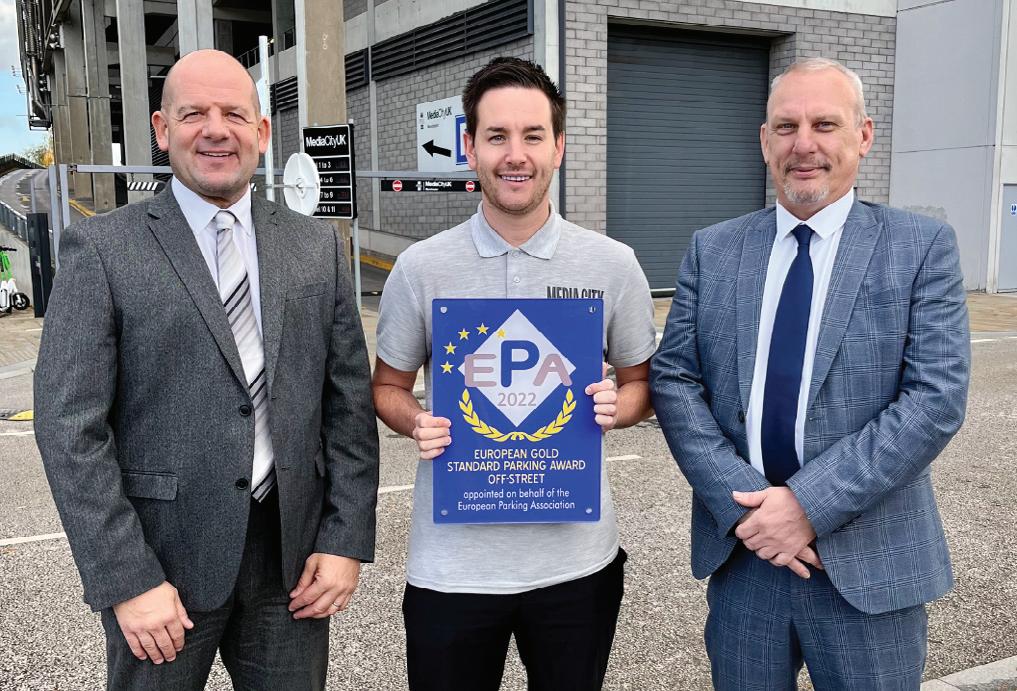














the operator’s storage sites
• Trading Standards’ Buy With Confidence accreditation.
Gatwick Airport has issued a fivepoint checklist to help passengers avoid being stung by rogue ‘meet and greet’ parking companies that operate from the airport.
Between May and October London Gatwick saw a 164% increase in complaints from passengers about third party ‘meet and greet’ parking companies, compared to the same period in 2019.
Despite often having ‘Gatwick’ in their company or website name, the airport has no relationship with these third-party firms. Gatwick said it cannot prevent competitor parking companies from operating on site, provided they abide by airport byelaws and terms and conditions of use.
The airport said complaints made about competitor ‘meet & greet’ operations include: vehicles being returned late or not at all;
Worcester City Council civil enforcement officers have stepped up patrols in the city centre after a spate of complaints about illegal parking around taxi ranks.
Besides monitoring the situation late at night on Fridays, Saturdays and Sundays, the CEOs are now increasing their presence at taxi ranks during mornings and late afternoons.
During November, a total 48 drivers received £70 fines for the misuse of taxi ranks.
On 18 November, the CEOs joined forces with staff from Worcestershire Regulatory Services to patrol the city centre checking for the misuse of taxi ranks and vehicles parked in restricted areas. This focussed action saw nine PCNs issued.
Cllr Richard Udall, chair of the Licensing and Environmental Health Committee, said: “Residents and taxi drivers have been complaining for some time about obstructive and illegal parking in the city centre, especially around or adjacent to taxi ranks.
“We have previously issued a number of warnings and asked for co-operation, but unfortunately a tiny minority of drivers have continued to ignore our warnings.”
vehicles returned dirty inside and out; lost keys; vehicles left in unauthorised or unsecure locations; and in some extreme circumstances, vehicles being damaged. There have also been reports of a significant increase in vehicle mileage. In one case, a passenger who had parked at Gatwick found a map of Bristol, that was not theirs, on their back seat.
Gatwick said it was keen to avoid passengers having their holidays ruined by rogue ‘meet
and greet’ or ‘valet’ parking firms, so has issued the following fivepoint checklist for its passengers, urging them to look out for:
• Positive reviews on Trustpilot, or other reputable review sites
• Full, clear contact details – not just a mobile phone number –on the company’s website
• Companies House Number, VAT Number and registered company address on their website

• British Parking Association’s Park Mark accreditation for all
Gatwick recommends passengers use the airport’s official, secure, on-site parking options via parking.gatwickairport.com. Gatwick Airport’s valet parking includes 360-degree, high-definition cameras to check vehicles for pre-existing damage. Cars are tracked at all times and stored in secure, Park Mark accredited facilities, with keys stored in a secure airport facility.
Gatwick guarantees users that their car will be waiting for them when they return, with their next booking free if it is not.

Gary Wallace, head of car parks, Gatwick Airport said: “”For complete peace of mind, we would always recommend passengers book with official Gatwick Airport parking. However, if considering using a third-party ‘meet & greet’ parking provider, we advise using our checklist before booking.”
• improving the safety and accessibility of key pedestrian routes, to encourage more people to walk and get healthier
• improving cycle routes, providing new cycle parking and cycle training, to make cycling safer and easier
• introducing a flexible ‘try before you bike’ scheme to help more people take up cycling
Low traffic neighbourhoods, controlled parking zones, 20mph zone School Streets all feature in the Royal Borough of Greenwich’s new transport strategy. The document promotes walking, cycling, public transport, reduced traffic, improved air quality and support for the roll-out of ultra-low emission vehicles.
The south-east London borough’s cabinet has approved the strategy following six weeks of consultation with residents. Consultation on the draft Transport Strategy ran from 17 August to 25 September 2022. Over 1,000 survey responses were received and
approximately 500 people attended a series of public events throughout the borough.
Key projects include:
• collecting the evidence to identify where low traffic neighbourhood schemes would be most effective
• taking decisions on making existing trial School Streets permanent and introducing more at schools around the borough to help reduce traffic and improve air quality

• creating more 20mph zones to improve the safety of our roads
• introducing controlled parking zones (CPZs) to reduce people’s reliance on cars
• working with dockless bike operators to improve residents’ access to affordable cycle hire and help ensure schemes are well managed
• increasing the number of electric vehicle charging points across the borough to support take up of electric vehicles
• working with car club operators to improve access to flexible hire cars.
The council will also support Transport for London in the delivery of phase two of the Greenwich to Woolwich cycle route (Cycleway 4), and further development of the scheme.
Projects such as LTNs, School Streets, 20mph zones and CPZs will all be subject to further consultation with local residents, to help prioritise where schemes are introduced and to help develop schemes that will benefit the borough.
Airport helps travellers avoid rogue operatorsGatwick’s official drop-off area Greenwich is planning more School Streets
Residents asked to help council map pollution problem
‘When you stop, engine stops’ is the message of an anti-idling campaign launched by Portsmouth City Council. The council is asking residents to consider the next generation, and, if public transport is not an option, to drive responsibly and not idle.

The campaign focusses on how a single minute of a car’s engine idling releases 150 balloons worth of harmful emissions into the air. It aims to evoke thoughts on how small changes to everyday habits can create big changes.
The council launched the awareness campaign just over a year after a clean air zone
(CAZ) was introduced during 2021 in a bid from government to lower air pollution rates in the city.
To help the council identify key target areas where engines are kept running, residents can report incidents of engine idling using an online tool – cleanerairportsmouth.co.uk/engine-idling
People do not need to include any personal details or the number plate of the idling car, and it will only take one or two minutes to complete the form.
Cllr Lynne Stagg, cabinet member for traffic and transportation, said: “Air pollution is a real problem that we need to act on now, for the health of our residents now and our next generations. Thousands of

A clean air zone (CAZ) has gone live in Bristol, making it the fifth UK city to introduce a scheme alongside Bath, Birmingham, Bradford and Portsmouth.
Bristol’s scheme is in the ‘Class D’ category, with a £9 daily charge applying to noncompliant private cars, taxis,
private hire vehicles and light goods vehicles, and a £100 daily charge for heavy goods vehicles, buses and coaches.
Failure to pay this daily charge will result in a penalty charge notice of £120, or £60 if paid within 14 days, as well as the outstanding daily charge.
residents are experiencing the health consequences of toxic air, yet we still see engine idling rife throughout the city.
“We cannot fix the issue alone – we need drivers to reconsider if their car journey is needed, and if it is, to reduce their engine idling wherever possible. We cannot forget that the carbon dioxide released by vehicles is also contributing significantly to climate change with rising sea levels, droughts, floods and severe storms. I hope to see residents remembering our campaign and either opting for public transport or switching off their engines, considering the 150 balloons worth of harmful emissions each minute of idling that will enter the lungs of those around them and pollute our air.”
Charges will not apply to:
• Euro 4, 5 and 6 petrol vehicles, roughly 2006 upwards
• Euro 6 diesel vehicles, roughly end of 2015 onwards
• fully electric vehicles and hydrogen fuel cell vehicles
• modified or retrofitted vehicles registered with the Energy Saving Trust’s Clean Vehicle Retrofit Accreditation Scheme (CVRAS)

• motorbikes.
Bristol’s CAZ runs from the Clifton Suspension Bridge to Temple Quay, and the Portway, along with the Cumberland Basin.
Penalty charge notices will be sent to those who drive noncompliant vehicles and do not pay the daily charge.
Mayor of Bristol Marvin Rees said: “No vehicles are banned from entering the central zone, and Bristol remains very much
open to all residents, visitors and businesses. We have always sought to reduce air pollution in Bristol to improve the city’s health, but we’re also mindful of the financial strain people are under at the moment. We have taken our time to find a way to clean up our air, while also providing support to those who need it most. Temporary exemptions and financial support are still available, and I urge people to check if they’re eligible.”
The council has received over 6,000 applications for financial support such as grants and loans to change or upgrade vehicles. Over 1,500 applications for temporary exemptions have been approved, mostly to Blue Badge holders, and over 8,000 active travel offers such as bus tickets and Voi scooter credit have been given out.
The British Parking Association members’ dinner at the De Vere Grand Connaught Rooms in London on 23 November marked the first time in three years that the BPA had been able to hold its annual dinner due to the impact of the pandemic.






The evening commenced with an address by Anjna Patel MBE, chair of the BPA board. “It is a fabulous community and I am so proud of it,” she said. “I am excited by what

2023 will bring, including the launch of our new BPA strategy. We need to continue to work collaboratively and encourage the younger generation to come through.”
BPA president Jade Neville spoke about how her term of office had looked at issues such as diversity, inclusivity and skills development, including the launch of Veterans in Parking. She said: “Someone said to me your comfort zone is a lovely place , but nothing ever grows there. We need to lean on our colleagues and push ourselves to really develop.”
The socialising was all in a good cause as evening raised some £8,000 funds for Macmillan Cancer Support via a silent auction and the sale of racing memorabilia donated by guest speaker Jade Edwards, the only female racing driver to have won the British Touring Car Championship.

Michelle Bischoff-Turner, BPA communications and marketing manager, said: “Thank you to all of you who came and supported our auction. Your generosity will make a huge difference to Macmillan.” www.britishparking.co.uk

Alastair Finlayson has been promoted to become general manager of Gemini Parking Solutions.
Finlayson joined Gemini Parking Solutions over six years ago as an administrator, having previously worked as a weekend supervisor in Primark.
His work ethic caught the attention of Gemini’s founder, Ryan Jackson, who put in place a personal development plan that would see Finlayson take on new responsibilities.
After a promotion to account manager, Finlayson progressed to become head of site and project management, where he interacted with clients across the country on a daily basis.

Finlayson was part of the team that earned Gemini Parking Solutions the title of Parking Provider of the Year at the British Parking Awards 2021.
Finlayson said: “I envision the
future of parking in a different light to that of a few years ago. I believe the public’s perception of parking can and needs to change, but the only way this can happen is from the industry itself.
“We have already seen a great shift into technology adoption, which makes people’s lives so much easier when finding, paying and extending their parking sessions – the final piece lies with how we deliver our service.
“Taking a values based approach can impact every aspect of the business. It is by embodying the values that you set, that motorists come to trust your company and see your parking system as a fair governing force that allows for a better experience for all.”
Gemini Parking Solutions specialises in managing off-street sites for clients in the retail, commerce and healthcare sectors. The company was acquired by APCOA Parking in 2022.


UK Parking Control (UKPC) has acquired Secure-A-Space, a company operating around 250 sites. Secure-A-Space was founded in 2014 and specialises in operating privately owned parking across East Anglia, London and South Wales.
The sites the company operates are mainly in the residential, retail and commercial sectors.
The acquisition will enable the owners of Secure-A-Space to take a step back from managing the business but still be involved with clients.
Mick Stiles, director at Secure-ASpace, said: “This acquisition represents a new chapter for Secure-A-Space and our clients. With UKPC’s growing estate and product offering, we are thrilled to join UKPC and transform our clients’ car parks using the latest technological solutions.”
Ben Cooke, chief executive of UKPC, said: “Secure-A-Space is a highly reputable car park management operator that provides its clients with a professional and personal service.”
We currently supply and have vacancies around the UK for Permanent and Temporary positions:
• Civil Enforcement Officers
• Environmental Enforcement Officers
• Parking Back Office (Appeals/Notice Processing/Correspondence)
• Parking Change Management
• Interim Parking Managers
• Car Park Attendants/Marshalls/Stewarding
Airport Parking & Hotels (APH) has once again been voted the Best Company for Airport Parking at the British Travel Awards 2022. This is the 12th year running that the company has won the category.
TV presenter Alison Hammond presented APH’s managing director Nick Caunter with the award at Battersea Evolution in London on 29 November.

Caunter said: “It has been an incredibly difficult few years for the travel industry and winning Best Company for Airport Parking for the 12th consecutive year is testament to the hard work and high level of customer service provided by the APH team.”
Lorraine Burton, chief executive of
the British Travel Awards, said: “Since 2008, the British Travel Awards has been celebrating travel companies recognised by customers as the best in the business. Airport parking is an essential part of the holiday ensuring it starts as soon as you leave home, and the huge number of votes APH receive each year is a tribute to the impeccable service APH customers receive.”
Launched in 1980, APH is a family-run business that runs car parks at Gatwick Airport and Manchester Airport.
APH also offers parking at all major UK airports as well as airport hotels, airport lounges and other extras such as car hire and travel insurance via trusted partners.
• Parking Supervisors (Both Enforcement and Back Office)

• Parking Management (Both Enforcement and Back Office)
• Heads of Parking/Directors
• Parking Technologies (Business Development and Project Managers/ Field Service Engineers/General Managers)
• Off Street Parking (Business Development, Contract Managers and Regional Managers)
• CCTV Operators – SIA and BTEC qualified
Looking for staff or need employment? Please contact our experienced team on: Tel: 0203 668 5680


Email: parking@unity-recruitment.co.uk Web: www.unity-recruitment.co.uk

General manager will focus on developing a values based operationAlison Hammond and Nick Caunter Alistair Finlayson
comes to parking their car, and the strength of public opinion against those who deliberately flout the rules.
Strength in numbers was the theme of the International Parking Community’s Annual Conference and Charity Gala Dinner, which was held at the Midland Hotel in the heart of Manchester. The phrase ‘Strength in Numbers’ has a dual meaning, reflecting the importance of parking providers working together and the value of empirical evidence as a new era of regulation for the sector approaches.
Working together was a theme emphasised repeatedly in a presentation and Q&A session from a representative panel of the IPC steering committee. It was also a theme in the keynote address by former Liberal Democrat MP David Laws, who was a Cabinet Office minister in the Coalition Government. Laws highlighted the value of using evidence and research in support of any dealings with cabinet ministers, junior ministers, civil servants and special advisers.
Laws emphasised the importance of engaging with MPs at a local level, and advised against resorting to any exaggeration when making claims, submissions or presenting new ideas to government. “The most important thing for any industry is to show that it is seen to be part of the answer to any concerns expressed by the public,” he said. “And that means using substance over supposition at all times and taking positive steps to correct any misinformed or mischievous popular narrative.”
Laws cited his personal experience as an MP in Yeovil, where the majority of complaints he received about parking were from stressed homeowners calling for more parking enforcement rather than the antics of so-called rogue operators. This view was also evident in a special vox-pop video commissioned for the conference to demonstrate the cavalier behaviour of some motorists when it

A technology panel comprising Ashley Bijster (Imperial), Duane Hodges-Stubbs (Tap2Park), Stuart Maclaren (Atria) and Hannah Fuller (ZatPark) offered insights into next generation parking technologies.
A resolution panel comprising David Chalmers (Debt Recovery Plus), Gary Carr (Empira) and Rohan Krishnarao (BW Legal) discussed a number of topical developments in the dispute resolution sector.

Chris Naylor, IPC membership and operations manager, provided an introduction to the IPC’s new compliance software system that will greatly simplify annual audits. He stressed the importance of the new system in helping to ensure all compliance records stand up to close scrutiny once the new code of conduct for parking on private land comes into effect.
The conference was followed by a charity gala dinner and auction which raised over £25,000 for good causes.

The IPC annual conference explored the value of harnessing information and working togetherThe IPC’s Will Hurley, HUB Parking Technology’s Lee Burton and comedian Justin Moorhouse present Annie Oliver of PCM (UK) with the Outstanding Employee of the Year Award David Laws
The International Parking Community’s Annual Conference culminated with the IPC Charity Gala Dinner, which was attended by guests from all areas of the industry. The dinner, which marked the accredited trade association’s 10th anniversary, saw the presentation of the IPC Awards 2022 and also a fundraising drive for the two nominated charities – Alder Hey Children’s Hospital and Made With Hope.

Hosted by the comedian Justin Moorhouse, the evening raised well in excess of £25,000 for the two charities.

Eleanor Teeling, founding director of Made With Hope, said she was “bowled over” with the funds raised for her charity. She told the attendees: “It was a fun evening for everyone and the massive sum raised will make such a huge difference in helping children in Tanzania to have access to education so they can break out of the cycle of poverty. On behalf of all our volunteers and all of the children we support, thank you!”
Her views were echoed by Becky Parsons, corporate partnership officer for Alder Hey Children’s Charity. “We are really touched by the generosity of everyone who attended the IPC Charity Gala Dinner,” she said. “It was clear that everyone thoroughly enjoyed the event and, of course, we are delighted that the event generated an amazing contribution to our special appeal to build and enhance a brand new Surgical Neonatal Intensive Care Unit at Alder Hey. Our heartfelt thanks go to everyone who contributed.”
The 2022 IPC Award winners were:
• Outstanding Employee: Annie Oliver, Parking Control Management
• Parking Team of the Year: Central processing office of Excel Parking Services
• Sustainability Innovation: District Enforcement
• Parking Technology: Transfer 360
• Special Award: Simon Renshaw-Smith of Excel Parking Services for his ‘Outstanding Contribution’ to the private parking industry.
The delayed introduction of the government’s new code of practice for private parking is as regrettable as it was avoidable, said International Parking Community’s chief executive Will Hurley in his address to the trade association’s 2022 annual conference.

“The onus is now on all parties – the industry, the government, motoring organisations and the motoring public – to reflect, take responsibility and push forward with real purpose if the best intentions of Sir Greg Knight’s parking bill are to be fulfilled.
“There is no justification for further prevarication as there is consensus on so many aspects of the new code. Where there is agreement, we should show agility, collaboration and initiative and now crack on without any further delay or disruption.
“This will deliver the benefits originally envisaged by ministers for the motoring public and simplify the transition to the new code for all landowners and operators. Moreover, it will finally bring an end to several years of frustration, uncertainty and confusion for everyone.
“Sir Greg Knight’s Bill initially made no mention of the level of the parking charge or the creation of a single appeals service, but by trying to do everything and failing to understand the complexity of parking processes, the government has achieved nothing.
“And, what if they get things wrong by reducing the deterrent and increasing non-compliance – a move that will inevitably result in a substantial increase the number of parking charges being issued?
“Is that really what the RAC Foundation and the motoring public want, when 99.77% of current parking actions by motorists in England and Wales are in fact fully compliant with parking regulations?
“Are we really prepared for the 0.23% of non-compliant motorists to deflect us from what everyone claims to be the target outcome –fairness and consistency – especially when so many of those who deliberately ignore the regulations are repeat offenders and persistent evaders? We only have to look to the far lower compliance levels in Scotland and the prevalence of repeat offenders in London to see the very real impact of less effective deterrents, not to mention the impact of a less effective resolution system and legal framework north of the border.
“It’s time for all parties to face up to the real facts, the real numbers. Not to continue to be deflected by sensationalised anecdotes and alarmist statements that deliberately or inadvertently disguise and distort reality. The truth lies with substantiated evidence, trust and understanding. And that must be the guiding light for all parties as we look to deliver best practice and improve service standards in a service area where demand continues to outstrip supply and is continuing to increase exponentially. That is also the only route for confident, progressive and well-informed decision-making – in the corridors of power, in the offices of parking operators and landowners and, not least, for motorists looking for a parking space.”
Will Hurley is chief executive of the International Parking Community www.theipc.info
Will Hurley hopes new code of practice for parking on private land will be implemented as soon as possible

This question isn’t as obvious as it looks at first glance. The tendency within the Parking industry would be to focus on ticketing, payments and so on, however that would be an oversimplification as there are any number of individual elements that can drive your overall process forward.
We think that you need to look at less what these elements are, but more how they are delivered so that the platform you use will seamlessly give you the results you want, when you want them.
So, let’s look at how best to deliver the modern parking process with:
move files around which will take time to process or swallow up precious resources.
People often confuse integration with exchange – as data exchange can often be much simpler to set up, but it really is worth investing the extra time in building system integrations wherever possible, using an Application Programming Interface (API).
Providers of Ticket Management systems, such as ZatPark, offer API integrations which automate the process of sending your unpaid notices to debt collection systems such as DebtView, and that not only eliminates the need to manually create a number of files, but also has it happen invisibly in the background or overnight so that the process delivers a seamless experience to the end user.
Whilst automation has been considered common practice for a while now, it often still entails user intervention in creating and processing files. Whether it’s getting the VRM (vehicle registration mark) via ANPR, then using that data to obtain the DVLA’s KADOE details and finally confirming the address as current via a trace supplier, all of this needs to be done without having to manually
Again, something that seems like a ‘no-brainer,’ but any amendments to your processes should always be looked at with an idea of how they might need to be amended again in the future.
It’s always tempting, when something changes, to take the easiest route to implementation and drop in temporary solutions or workarounds that might fix the immediate issue. This is a tricky strategy to follow, as it often then drives additional workarounds
built on top of each other, or a more involved remediation exercise further down the line.
Flexibility can be as simple as having the ability to be able to configure different rules or charges for each individual site being operated (even if there isn’t a current need to do so), as with the Parking Code of Practice you never know when that may become a requirement.


This is best defined as having nothing in place that will impair your ability to grow in pace with the market. This can be as specific as having an awareness of soft limits embedded within any licensing agreements that you enter into (as most software packages come with license limits or stepped charges for data used), but all the way to looking at the stress points in your company if volumes increase or decrease.
A well-designed cloud-based system can scale up (or down) the memory, processing power (CPU), and database storage at the flick of a switch, often without the end user realising it has happened. At the end of the day, if you are investing in a system, you should
be confident that system will grow with you. You also need to be sure that the supplier has the resources and willingness to continue to evolve the product by keeping up with changes in technology and adding new innovative features.
This is the easiest section to define. Whilst enterprise companies will talk about the principles of LEAN and eliminating ‘muda’ (waste) – those of you who have gone through this will know that it means to simply look at what you want to do and judge it by whether it adds customer value and reduces overall strain on time and resources. A great example for this is to look at how much time and resource is devoted to the initial training of your users. Training should be easy to understand, quick to deliver and comprehensive enough to ensure customer satisfaction – without having to revisit or reinforce it over time.
In summary any end-to-end process should be scalable, flexible and always drive simplicity. As Indigo Cloud was one of the earliest adopters of cloud-based computing; that’s the methodology we have based our DebtView collection platform around over the last 10 years.

Eynsham
Construction work has started on Oxfordshire County Council’s new Eynsham park & ride.

The P&R – located on the A40 eastbound in Eynsham – is part of an investment in the A40 to deliver better facilities for walking, cycling and those using public transport. The 850-space interchange, located on the A40 eastbound, is intended to help reduce traffic congestion and provide regular, reliable public transport services into and beyond Oxford from the west.
Park & ride users will benefit from 24-hour security, dedicated cycle storage, public toilets and electric vehicle charging bays.
The site will be accessible 24 hours a day and is designed with dedicated access and exit routes. A new roundabout will make it easy to access from either direction on the A40.
Local councillors joined Balfour Beatty and Stagecoach West at the site on 12 December. Attendees were shown artist impressions of the park & ride before ceremonially breaking ground to mark the start of construction.
Cllr Duncan Enright, cabinet member for travel and development strategy, said: “I’m really pleased to celebrate the impending start of construction with some of our key partners in this project. I’m looking forward to
watching the Eynsham park & ride take shape over the next couple of years. Once complete it will encourage more people out of their cars and onto a
more sustainable mode of transport, one of our brilliant buses.
“The park & ride is one part of wider improvements we have planned for the A40 and we are
committed to improving people’s journeys along this crucial road.”
Work has picked up pace since site clearance began in October. Preparations were made in November for heavy machinery to be brought in, and key excavation and earthworks will start in the first week of January following the Christmas and New Year break.
The park & ride is expected to be finished in early 2024 and open for use in late 2025, once other improvements are completed.
Chris Hall, portfolio director at Balfour Beatty, said: “Marking the next phase of the programme of improvements planned on the A40 corridor, the scheme will provide residents and commuters in Eynsham and beyond with a reliable public transport service into Oxford.”
Rachel Geliamassi, managing director of Stagecoach West, said: “We are excited to see the work starting on site and will look forward to seeing the progress as it evolves. This park & ride will be an important transport hub providing sustainable travel options for people to connect to great bus links.”
The park & ride on weekdays is expected to be used primarily during the morning peak period with modest arrivals and departures throughout the day and empty through the evening peak.
It is estimated the available capacity is sufficient to attract up to a third of current total peak vehicle per direction.
A 21-storey residential tower block with 570 flats could be built on the site of a car park in the centre of Bristol. The project has been proposed by real estate company Global Mutual, development consultancy Pegasus Group and student accommodation operator Student Roost.

The planning proposal would see 250 ‘co-living rooms’ for young people and key workers as well as 320 student rooms built at the NCP multi-storey car park site on Rupert Street in Broadmead. Some 20% would be classed as affordable. The scheme will also feature cafés and co-working spaces.
As well as the 498-space multi-storey car park, the site currently includes two ground floor retail units occupied by Evans Cycles and Professional Music Technology.
While the car park in Lewins Mead would be removed, a replacement will be built. The new car park will provide 412 spaces.
“Plans for this new community at the heart of the city will benefit this area of central Bristol. Our plans will create new homes for key workers, graduates and young professionals to stay in Bristol, as well as helping address the demand for student accommodation in the city.
“There will be a focus on biodiversity, adding greenspaces, gardens and roof terraces. This will ensure that we are able to improve the local environment by redeveloping this brownfield site. This sustainable location in the heart of the city represents an ideal opportunity to provide homes that Bristol needs, whilst at the same time, adding value to the local community. The architecture will be grounded in the uniquely Bristol ‘Byzantine’ style, drawing upon many well-loved Bristol buildings and given a contemporary
site will have 850 secure spaces and provide EV chargersMark Osborne from Alec French Architects said: interpretation.” Representatives from Oxfordshire County Council, Balfour Beatty and Stagecoach West celebrate breaking ground at new park & ride. (L-R) Cllr Dan Levy (Oxfordshire County Council active travel champion), Rachel Geliamassi (managing director, Stagecoach West), Cllr Duncan Enright (cabinet member for travel and development strategy), Karen Coventry (commercial director, Stagecoach West), and Chris Hall (portfolio director, Balfour Beatty)
A multi-storey car park in Exeter city could be demolished and the site used for housing. The St Mary Arches Street car park would need a £3.8m refurbishment to extend its usable life, according to the city council.

St Mary Arches needs a number of upgrades including structural, surfacing, accessibility and decoration works. The lifts have not worked for over five years and bringing them back into use would cost £240,000 alone.
Faced with this bill, Exeter City Council’s executive has approved the car park’s demolition and to use the site for a residential-led mixed use development.
A report by council finance director Dave Hodgson said a public consultation on the site’s future could start in the new year, followed by a planning submission in August and demolition of the car park during November.
The council has secured £1.3m
of government funding towards the cost demolition and asbestos removal.

Clearance of the site would enable redevelopment to begin in January 2024, said Hodgson.
The closure of the car park will mean the loss of 481 parking spaces in the city centre, but the report states there is spare capacity in the area.
The finance director said the proposed regeneration scheme is in the public interest and would improve the wellbeing of
residents in a number of ways, including by increasing the city’s housing supply.
The report said: “In addition, the site is a key gateway to and from the north of the city and a high-quality scheme will contribute towards the positive forward-looking image of Exeter ensuring it is an attractive place where people choose to live, work, study and visit.”
Hodgson added that part of the site was of archaeological interest.
Eight accommodation pods for homeless people are to be erected on a car park in Bristol.
The single bed units will be installed at the Derby Street car park in St George. The units will be used for move-on accommodation for rough sleepers. Each Solohaus unit will contain a living and kitchen area and shower.
A total of 22 of the 45 parking spaces will be used to make room for the modular units.
The temporary units received planning approved from Bristol City Council development control committee. There were 37 objections, with some people concerned about the proximity to St George Preschool and Redfield Lodge care home because of antisocial behaviour at the car park.
The pods will be managed by the Salvation Army, which has worked with the council and developers Hill Residential on the project.
The units will be below national living space standards, meaning any resident can only live there for up to two years.
Demolishing car park will make space housing, says reportSt Mary Arches
help us provide better service to motorists across the nation.”
Ashdown Forest is famous as the landscape that inspired AA Milne to write the adventures of Winnie-the-Pooh. The author lived on the edge of the forest and conjured up stories when exploring the woods with his young son Christopher Robin.
Covering over 10 square miles, Ashdown Forest is one of the largest open access areas in Southeast England. Situated within the High Weald Area of Outstanding Natural Beauty, its lowland heathland and deciduous woodland habitats are home to many rare and threatened species.
Since November, visitors have had to pay to park. The trust that runs the woods says it is facing increasing visitor numbers and decreasing levels of funding. The parking charges will be used to improve facilities, including maintaining paths and tracks, and clearing up rubbish.
James Adler, chief executive of the Ashdown Forest, said introducing the charges had been a difficult decision. “Having considered a wide range of alternatives, we believe parking payments will generate a proportion of the income we need to keep the forest safe and open for the public. We hope that people will understand that without this income we cannot protect this
unique landscape now or for the future.”
The parking fees range from £2 for an hour to £5 for all day, or £80 for an annual pass. Visitors can pay by phone, card, cash or app.
Planning permission was granted to install signs in the car parks and two parking machines at the Forest Centre in Wych Cross.
The Board of Conservators was set up in 1885 and is regulated by the Ashdown Forest Act 1974. There are 16 members on the board with representatives from East Sussex County Council, Wealden District Council and local commoners who live on and around the forest.
Ashdown Forest’s conservators appointed Horizon Parking to operate its 45 car parks for visitors. When it came to selecting a phone-based system, instead of appointing just one

service provider Horizon opted to join the Open Market, a RingGo platform that enables motorists to locate, manage and pay for parking using their favourite parking provider.

The aim of the Open Market is to reduce the hassle of downloading multiple apps and open the door to increased connected mobility services for an easier end-to-end user journey.
While RingGo is now live across Ashdown Forest, it is just one of five cashless parking providers made available for motorists to pay for their parking whilst visiting Ashdown Forest. Payments can be made via Horizon Spaces, RingGo, JustPark, PayByPhone and YourParkingSpace.
Will Dickson, UK director of Horizon Parking, said: “We’re excited to be forming relationships with leading cashless parking providers like RingGo. These new collaborative projects will
The Open Market parking model is being used in the UK. In Europe it is being rolled out by RingGo’s parent EasyPark in the Nordics, the Netherlands and Germany.
Ashdown Forest is the third UK destination to join the Open Market, and Horizon is the first private sector parking operator to participate. The other two are Manchester City Council and Oxfordshire County Council, which are accessing the Open Market in the context of the National Parking Platform.
Peter O’Driscoll, managing director of RingGo, said: “At RingGo, we’re proud to be leading the Open Market roll-out. We think this marks a significant point in mobility, as we’re able to harness digital innovation to create a cost-effective, seamless parking solution, where user experience is at the heart.
“The Open Market model allows motorists to use their preferred app throughout Ashdown Forest. New cashless paid parking environments enable motorists to make their payment choice based on their personal preference, putting convenience, price, and unique features at the heart of the user experience.”
In the wider area, RingGo has a presence across several Sussex and Kent local authoriities, including the likes of Arun, Eastbourne, Hastings, Horsham, Lewes and Rother councils.
Cashless parking provider RingGo has launched its new Scan & Pay product in Solihull, West Midlands. The pre-Christmas launch coincided with the introduction of RingGo at the Touchwood Solihull shopping centre.
Motorists can avoid queuing at parking machines and are simply able to manage and pay for parking sessions via their RingGo app. This effectively saves customers valuable time from avoiding the lengthy ticket machine queues.
Tony Elvin, general manager at Touchwood Solihull, said: “It has been great to work with RingGo to


grant our shoppers a simple, swift, and seamless cashless parking experience. We look forward to the partnership continuing, and anticipate that this will bring new levels of convenience for festive shoppers.”
Peter O’Driscoll, managing director at RingGo, said: “We are thrilled to be expanding the RingGo cashless footprint at Touchwood Solihull. At RingGo, we are committed to providing a seamless user experience, while making paying for parking as simple as possible, and we’re excited to fuse our customer experience vision with that of Touchwood Solihull.”
Scenic spot joins RingGo Open Market to offer drivers multiple payment options
RingGo’s new Scan & Pay service launched at Touchwood Solihull
Transport for London shares priority road network restriction data with AppyWay

Transport for London (TfL) has shared its Red Route kerbside restriction data with AppyWay to unlock even more of the capital via its driver app, AppyParking+. This means that drivers in London can now see when, where and for how long it is okay to park along these routes.
Making up 5% of London’s roads, but carrying up to 30% of the city’s traffic, TfL’s Red Routes are an important part of journeys across the capital. The Red Routes help reduce congestion and ensure crucial deliveries and journeys can be made safely to keep the city moving.
Unless otherwise stated, these major arterial routes with single and double red lines are no stopping at all times. However, TfL who manages restrictions on Red Routes, do in fact allow parking along them in specified areas, for specified periods, when their use will not cause any major disruption to the capital’s busy road network.
AppyWay is an intelligent kerbside company empowering local governments to activate decarbonisation efforts and helping fleets and drivers reduce mileage.
Its driver app, AppyParking+, enables drivers and fleets to access detailed parking restriction information for all 32 London boroughs. AppyParking+ is a parking app which helps drivers across the UK better plan their journeys by providing accurate information on spaces and restrictions. The app thus aims to help drivers find and navigate to parking quickly and efficiently,
in turn reducing mileage, fuel usage and congestion.
To cover all of London’s kerbside, AppyWay and TfL worked together to make it easier for people to understand the parking restrictions on London’s priority road network.
With TfL’s help, the AppyParking+ app
ZatPark parking management systems are being integrated with image processing and ANPR systems developed by ARVOO.
ARVOO hardware and software imaging solutions are used in the agricultural, traffic and rail industries. Its traffic and ANPR camera systems are used in traffic research, parking enforcement, access control and low emission zone enforcement. The company also develops public space sensors and railway crossing safety systems.

ARVOO develops both hardware and software systems in-house.
Jonathan Hector, UK business manager for ARVOO Imaging Systems, said: “I’m very pleased to be announcing this partnership with Unity 5 and the ZatPark software


suite. Our industry leading ANPR technology is a perfect match for the professional systems ZatPark develops, and our integrations will enable ZatPark’s users to maximise ANPR performance and the reliability of their projects.”
Jono Clark, technical services lead at ZatPark, said: “We are proud to have formed integrations with so many of the parking industry’s leading tech innovators, and this one with ARVOO is no exception. Their ethos and commitment to the highest levels of accuracy will be a particular benefit to our clients.”
now displays all Red Route parking information for London. This means drivers in London can experience improved journeys around the capital. Delivery services, trades and more can safely load and unload, and Blue Badge holders can park, pick-up or drop-off much closer to their destinations.
AppyWay founder and chief executive Dan Hubert said: “Through AppyParking+ we have proven the importance of putting kerbside data into the hands of London’s drivers. Everyday drivers can make informed travel decisions, and fleets are able to optimise their operations. This means fewer miles are driven by today’s transport, and drivers transitioning faster to carbon-zero options. Red Route data is another piece of this allimportant kerbside puzzle and we’re thrilled to be sharing this information with users of AppyParking+”
Nick Owen, TfL’s head of network performance, said: “Parking restrictions around the capital play an important role in reducing motor traffic, and enabling more walking, cycling and public transport use. People driving should only stop or park on Red Routes where permitted and we want to make it as simple as possible for people to understand where they can and can’t park. Adding this data to the AppyParking+ app will make our parking restrictions even clearer, and we hope that this increases compliance with these vital restrictions.”
AppyParking+ is available for free or via a subscription that unlocks even more time and money saving features. Premium subscribers can access exclusive parking insights such as intel on when paid bays will become free, or whether the next street over has cheaper parking.
Consultancy RTA Associates has launched a managed service that hosts digital traffic and parking orders, documents and parking data.
RTA OrderPro is designed to map and keep digital records up-to-date, making it easier to make, advertise and amend traffic orders. The service provides an end-to-end order making process, creates and maintains a map-based history of order making and prevents the use of out-of-date data.
Highways authorities can make, advertise, consult and seal new or amended orders using the RTA OrderPro public portal and can display up-todate data on their websites.
Proposals are mapped professionally, even from sketches, with RTA turning these in to fully working drawings and plans.
For maintenance teams, RTA
OrderPro has a query module so authorities can create work packages for contractors undertaking remedial works.
The provision of a full history of the data will help ensure the correct enforcement and administration of penalty charge notices, and help provide evidence to tribunals in the event of appeals. The data can be used to update the UK Tribunals order libraries, civil enforcement handheld devices and parking administration services.
Peter Lowe, managing director of RTA Associates, said: “We are currently working towards integration of the mapping data with the National Parking Platform. The service has been built and evaluated over the past three years, including input from local authorities to refine the product.”
Organised by:
Presented by:
Headline Sponsor:

Wednesday 17 May 2023 l 15 Hatfields, London SE1
Mobility hubs are spaces where public, shared and active travel modes are co-located alongside improvements to the public realm. They enable travellers to make smooth and safe transfers between different modes, swapping private cars for shared vehicles, bikes, buses, trains, scooters or walking.
When reimagined as mobility hubs, car parks and park & ride sites are no longer just somewhere to store vehicles. Instead they become genuine interchanges. Meanwhile, the provision electric vehicle (EV) charging points at mobility hubs supports the transition to zeroemission vehicles.
The emergence of service hubs is also seeing car parks being transformed into logistics bases for last-mile delivery services, click & collect locations and homes to dark kitchens and dark stores.
The second annual Mobility Hubs conference sees speakers and expert panels explore the design, implementation and operation of mobility, EV and service hubs. The day will draw on real world experience and showcase best practice from around the UK and internationally.
The Mobility Hubs 2023 conference will address themes such as:
l Planning mobility hubs
l Developing service hubs l Mobility hub design
l Making space for hubs in car parks
l Rethinking park & ride schemes l Creating kerbside hubs
l Connecting with public transport l Providing EV charging
l Hosting shared transport services l Linking into active travel schemes l Hub operation

l Hosting click & collect services l Last-mile delivery schemes l Scheme accreditation
If you are interested in speaking or taking part in a panel contact Mark Moran at: mark.moran@landor.co.uk
www.mobilityhubs.uk
l Car park operators l Local authorities l Property companies l Car club operators l Micro-mobility specialists l Logistics companies l EV charging providers l Consultants l Architects l Facility managers l Public transport operators l Retailers l Construction and refurbishment contractors l App developers l Technology providers
The event’s exhibition provides an excellent opportunity to showcase your systems and services. To find out how your organisation can be part of the day contact Jason Conboy on: jason.conboy@landor.co.uk


Editorial Managing editor:
Mark Moran
Tel: 020 7091 7871
mark.moran@landor.co.uk
Production and design production@landor.co.uk
Advertising, sponsorship, marketing and exhibition packages
Jason Conboy Tel: 020 7091 7895 jason@landor.co.uk


Subscriptions
Christina Pierre Tel: 020 7091 7959 subs@landor.co.uk
Accounts
Irina Cocks Tel: 020 7091 7854 irina.cocks@landor.co.uk
Business manager
Rod Fletcher Tel: 0191 280 1410
Printed by: Pensord Tram Road, Pontllanfraith, Blackwood NP12 2YA
Published by: Landor LINKS Ltd, Apollo House, 359 Kennington Lane, London SE11 5QY
© Landor LINKS Ltd 2023
www.landor.co.uk
Registered members of:

The Independent Press Standards Organisation www.ipso.co.uk
The Professional Publishers Association www.ppa.co.uk
COVER: An accessible charger prototype by Designability
During November and December a number of electric vehicle charging terminals across Britain were wrapped with artwork which depicted people with a range of disabilities playing in a park while a car was re-charged.


The artwork by Ella Murray, called All in Charge, was commissioned by Osprey Charging to celebrate UK Disability History Month. All in Charge reflects the fact that for many people with disabilities and limited mobility, having an automobile enables them to access services and lead independent lives. The artwork underlines how vitally important in that, as most vehicles become electric, public charging infrastructure is designed and managed so as to be accessible to all.
The charity Motability conducted research which that there will be 2.7 million disabled drivers by 2035, with up to 50% expected to be partially or wholly reliant on public EV charging.
And it is thanks to Motability the positive vision depicted in All in Charge stands a good chance of becoming reality. The charity has worked with the BSI to develop PAS 1899:2022, a standard that gives designers, procurers and installers specifications on how to provide accessible public chargepoints. Hopefully the standard will become essential reading for the sector.
Mark Moran Editor
It is important that public EV infrastructure is designed to be accessible to everyone

One in five people in the UK have a disability. By 2035 1.35 million disabled drivers will be partially or wholly reliant on public EV charging. However, key research has shown there is a lack of accessibility for disabled people across existing EV chargepoints.
The sale of new petrol and diesel vehicles will end in the UK by 2030. The UK currently only has 10% of the EV chargepoints it needs, accelerating the need for rapid change in EV charging design and installation to ensure no one is left behind in the transition to electric vehicles.
The charity Motability conducted research which estimates that there will be 2.7 million disabled drivers by 2035, with up to 50% expected to be partially or wholly reliant on public EV charging.
In response to these challenges, Motability and the Office for Zero Emission vehicles (OZEV) formed a partnership to co-sponsor PAS 1899:2022, a new accessibility standard for public EV chargepoints developed by the BSI in its role as the national standards body (NSB).
The new British standard for the design of electric vehicle chargepoints aims to provide an inclusive experience for people with accessibility needs. PAS 1899:2022 gives designers, procurers and installers specifications on how to provide accessible public chargepoints.
The standard covers the physical aspects of the environment surrounding
fixed chargepoints (e.g. kerb height, ground type); the location, placement and spacing of chargepoints within the streetscape/public realm; the information, signals and indicators to be provided to users; and the factors to be taken into account in the design and specification of accessible chargepoints (e.g. height of chargepoint, cables and cable management systems, bollard spacing, colours used on screens, weight and force and ease of use of the equipment).
The BSI hopes that PAS 1899:2022 will help designers, procurers and installers to:
• anticipate and overcome restrictions and barriers that could prevent any user making full and independent use of the chargepoint
Designability has published design guidance that aims to make public electric vehicle (EV) charging accessible for all.
Alongside commissioning the BSI to develop PAS 1899:2022, Motability and OZEV awarded Designability grant funding to explore electric vehicle charging solutions for the benefit of disabled drivers.
The Designability guidance comprises concise information, images and videos. It looks at areas such as:
• information and signage on where to find the chargers and how to use the chargepoints
• lighting the area around the chargepoints
• size of parking bays to allow enough space around the vehicle
• clear access to amenities like toilets
• cable and socket types
• design examples from a set of prototypes developed as part of the process.
Designability is a national charity that enables disabled people to live with greater
independence.The team at Designability are a diverse mix of designers, engineers, occupational therapists, technicians, fundraising and administrative staff.
Designability carried out research and user testing working with disabled people to understand the challenges with current EV charge points and to inform freely available design guidance for manufacturers, installers, providers and site owners, of public EV chargepoint infrastructure, to ensure


• accelerate innovative practices
• improve the efficiency with which EV chargepoints are deployed
• build confidence in the accessibility and inclusivity of EV infrastructure
• strengthen the risk management of EV projects.
The PAS can also be used by owners and operators to assess the accessibility of their existing chargepoints.
Scott Steedman, director-general, standards at the BSI, said: “The new standard will help ensure that charging point providers and procurers can anticipate and remove any obstacles that could prevent a user from making full and independent use of the charging point.”
accessibility for all users.
Designability’s chief executive Catharine Brown said: “We strongly believe no one should be left behind in the transition to electric vehicles. All disabled people should be able to live the life they choose, with greater independence, and feel empowered and included in everyday life.
“This is a crucial time for us to ensure public EV charging is the best it can be, and accessible for all. The standard positions the UK as world leading in this area. We are really excited about the future of public EV charging and how it will help disabled people to feel included, listened to and enable them to play their part in the transition to electric vehicles.”
Barry Le Grys MBE, chief executive officer at Motability said: “Motability’s research has shown that half of disabled people will be reliant on public EV charging by 2035, yet they face a host of problems using existing public chargepoints. As the UK transitions to net zero we want to ensure that EV charging is accessible to all. This new free design guide, grant funded by Motability, is a fantastic resource that will help providers develop new infrastructure at pace which is fit for the future of travel.”
The UK government’s new Electric Vehicle Chargepoint Grant (EVCG) scheme has funded the installation of 972 sockets since the scheme was launched in April 2022, data released by the Department for Transport reveals.
The Office for Zero Emission Vehicles (OZEV) provides grants to support the use of electric vehicles, including the installation of charging devices in the UK.
The EV chargepoint grant provides funding of up to 75% towards the cost of installing electric vehicle smart chargepoints at domestic properties across the UK. It replaced the Electric Vehicle Homecharge Scheme (EVHS) on 1 April 2022.
The EVCG scheme can be broken down by type of grant:
• Electric Vehicle Chargepoint Grants for landlords: grants for properties that the applicant owns or manages but does not live within.
• Electric Vehicle infrastructure grant for residential car parks: grants to provide chargepoint infrastructure in residential car parks.
• Flat owner-occupiers and people living in rented properties: grants for electric vehicle drivers who live in a flat or rental accommodation.
As of 1 October 972 sockets have been installed, this corresponds to £682,343 in grants.
The majority of the grants which have been installed are for flats and renters with 562 sockets installed, this accounts for 58% of installations. The next largest grant type is for residential car parks with 355 sockets installed, accounting for 37%. The remaining 6% is for the landlords whose grants had installed 55 sockets.
Car parks and landlords can apply for larger grants, as opposed to a flat which will always only have one installation.
Previous OZEV funded grant schemes (EVHS and DRS) have delivered 375,523 domestic charging devices since 2013. Since September 2014, a total of 335,190 domestic charging devices have been installed, with a total grant value of £139m.
In the last 12 months the number of EVHS funded charging devices has increased by 97,287, corresponding to an additional £38.38m in grant value.
In addition to the EVHS, the Domestic Recharge Scheme (DRS) has also helped
Cumulative growth of EVCG funded charging socket across the UK: The cumulative increase in the number of Electric Vehicle Chargepoint Grant funded charging sockets from March 2022 (As of 1 October 2022, a total of 972 domestic charging sockets have been installed)
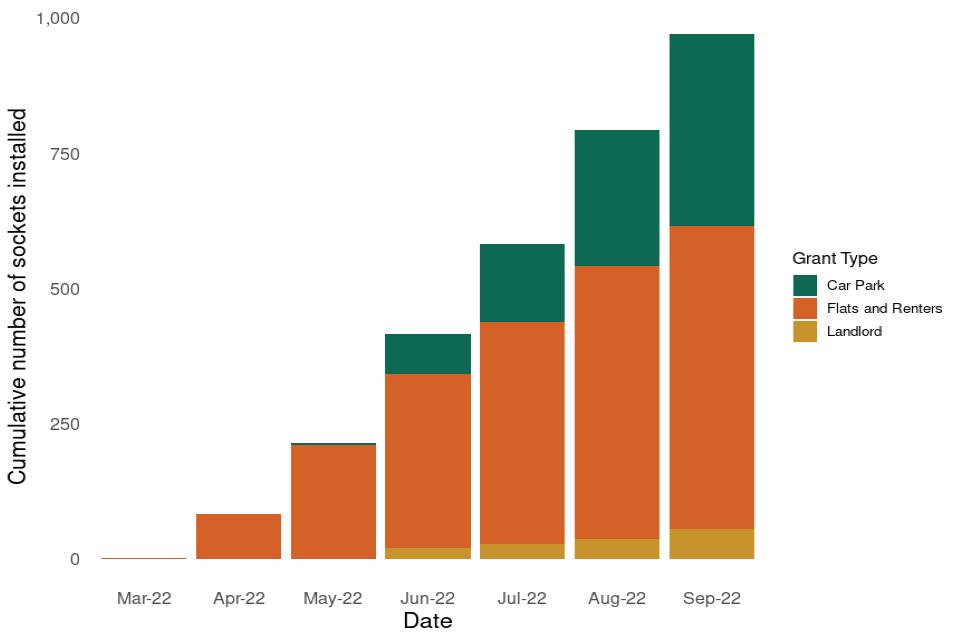
private plug-in vehicle owners offset the upfront cost of the purchase and installation of a dedicated recharging unit. This funded an additional 40,333 domestic charging device installations between 2013 and 2014, before it was replaced by the EVHS. Together, the EVHS and DRS have contributed to the installation of 375,523 domestic electric vehicle charging devices across the UK as of 1 October 2022.
There was an uneven geographical distribution of EVHS charging devices within the UK. Grant uptake by consumers is likely to be dependent on a variety of factors, including:
• access to an electric vehicle
• access to off-street parking
• leasehold/tenancy properties
• car ownership
• rurality
• income.
The South East had the highest number of charging device installations under the EVHS (62,465), accounting for 19% of total devices installed under the scheme. Meanwhile, Northern Ireland had the lowest number of installations with 5,794 EVHS funded charging devices, accounting for just 1.7% of total EVHS funded devices.
The South East also had the highest number (1,694) of EVHS devices per 100,000 households whilst Northern Ireland and London had the lowest with less than 800 devices per 100,000 households.
The Department for Transport has released data on the take-up of funding for workplace charging devices and on-street residential chargers.
As of 1 October 2022, the WCS has funded the installation of 36,317 sockets in workplace car parks since the scheme started in 2016. The WCS funded 15,075 sockets installations since 1 October 2021, an increase of almost 51% compared to the previous 12-month period.
The WCS is a voucher-based scheme designed to provide eligible organisations with support towards the upfront costs of the purchase and installation of electric vehicle charging devices. If an application is successful, applicants are issued with a unique identification voucher, which can then be used to install multiple charging devices.
In these statistics, the number of sockets installed is counted as sometimes there is one grant for up to four charging devices in the same workplace car park.
On-Street Residential Devices (ORCS)
As of 1 October 2022 the ORCS has funded 3,281 public charging devices which have been installed across local authorities in the UK. Some 312 onstreet charging devices were installed after being claimed for by the local authorities in the previous three months. Funding has also been awarded for 10,255 additional ORCS charging devices to be installed in the future.
This scheme is available to all UK local authorities to fund up to 60% of the capital costs of installing on-street residential charging devices to ensure that those without private off-street parking are able to access reliable and affordable charging infrastructure.
Until 1 April 2022, the scheme covered up to 75% of the capital costs of installing on-street residential charging devices.
Disabled motorists identify the lack of a disabled parking bay as the biggest barrier to accessing public charging infrastructure, a survey conducted by the charity Disabled Motoring UK (DMUK).
In April 2022 the charity was awarded funding from the National Lottery to research worries and concerns which disabled motorists have regarding the ban on the sale of new petrol and diesel vehicles in 2030 and switch over to electric vehicles (EVs).
DMUK surveyed participants from May to September and received over 2,000 responses. The survey asked participants to rank in order from 1-6 what would pose the biggest difficulty to them when using public chargepoints: 1 being the biggest difficulty and 6 being the least. The options were:
• dexterity required to plug in cable to charger and car
• lack of an accessible parking bay
• height of machinery
• complexity of charging machinery and booking/payment apps
• machinery being on a plinth without a dropped kerb
• weight of charging plug and cable.
The main problem was clear from the results with 41% saying that their biggest difficulty would be a lack of a disabled parking bay. Most other results had equal weighting. The other major concerns
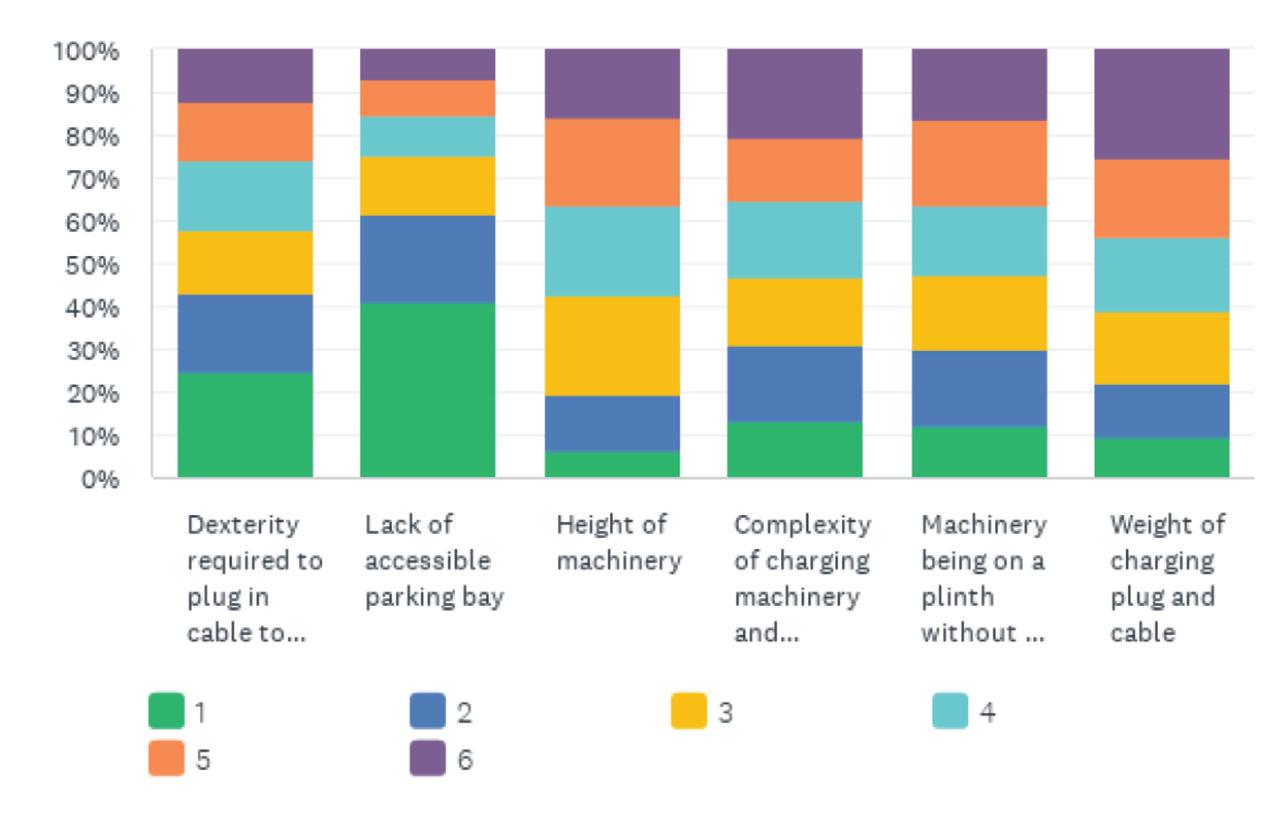
The DMUK survey asked participants to rank in order from 1-6 what would pose the biggest difficulty to them when using public charge points: 1 being the biggest difficulty and 6 being the least
included the cost of purchase and the worry of charging on longer journeys.
Some 45.7% of people ranked the cost of purchasing an EV as the thing that concerned them most, with the worry of charging on longer journeys coming in as second most concerning at 12.5%.
Heidi Turner, DMUK’s communications and campaigns director, says: “EVs are becoming more widespread, but there is yet to be an established secondhand market for such vehicles. There is no clear understanding of resale values and secondhand EV reliability. This is off putting to all motorists wanting to make the switch, especially with the cost of new EVs being so high. The ban on the sale of new petrol and diesel vehicles is moving closer and it is clear from the results of
A new free online resource has been launched for local authorities looking to install public electric vehicle chargers in their communities.
The EV Infrastructure Hub has been launched to act as an independent source of information.
Announced as part of the government’s Local Electric Vehicle Infrastructure (LEVI) funding programme, the hub is supported by the Office for Zero Emission Vehicles (OZEV), UK Research and Investment (UKRI) and Innovate UK.
Development of the hub has been a collaborative effort between the London Borough of Hammersmith & Fulham working with private sector partners including chargepoint operator Liberty Charge.
The EV Infrastructure Hub includes practical video content and case
study evidence from local authorities who have well-established EV charging networks in preparation for the UK government’s 2030 ban on the sale of new petrol and diesel vehicles.
Besides providing access to best practice on launching schemes, the hub can be used to inform public engagement, providing advice and guidance to overcoming objections, with advice on how best to recruit external consultants and chargepoint operators.
The hub sets out the importance of attracting a suitable private sector partner to the ongoing success of EV infrastructure projects.
Further information and assistance is provided regarding the process of chargepoint operator site reviews, site surveys and the design and safety elements of site location.
this survey that more needs to be done so that disabled motorists can move forward with this transition. Some of the problems highlighted in the survey aren’t unique to disabled motorists. The cost of purchase, the worry of charging on longer journeys and availability of public charging will affect all motorists. However, the lack of accessible public charging is problematic.
“From the survey the biggest concern on public charging is the lack of a disabled parking bay. In recent BSI guidance issued on accessible public charging (PAS 1899) the provision of a disabled parking bay is just an annex to the document. Our survey suggests that this needs to be at the forefront of any guidance to make public charging truly accessible.”
A simple starter guide aimed at helping local authorities understand the challenges around delivering onstreet charging networks for electric vehicles has been published by the Transport Technology Forum (TTF).
The eight-page document is designed to give authorities an idea of actions required to deliver EV chargers on the public highway. The high-level guidance is written for people familiar with installing equipment on the roadside, but may not yet know what specific requirements they may have to consider for EV chargers.
The guide has been developed by the TTF’s Electric Vehicle Infrastructure Charging Working Group with the support of the Office of Zero Emission Vehicles (OZEV). It is written to complement more comprehensive guidance to be
published by OZEV.
The drafting of the guide was led by Shamala Evans-Gadgil, EV programme/project manager at Coventry City Council, who explained that it has been produced in response to requests from counterparts in other authorities who wanted a high-level introduction into what is an area of growing importance. She said: “This document is about empowering local authorities, especially those who haven’t started yet, to begin this journey and provide that initial kickstart document to help them build their EV network,
“This guide lists key deliverables and the stakeholders required and provides links to more detailed guidance and standards that should be referred to as an authority’s plans become more mature.”
DMUK asks drivers about experience of using EV charging infrastructure
Location data will help build an electric vehicle (EV) chargepoint network, ensuring the right infrastructure is built in the right places, giving confidence to current and future EV owners that they can efficiently reach their destination. This is a key finding of a report by the Geospatial Commission, which has published a report on how location data can support the rollout of electric vehicle chargepoints. The commission has also announced a project to improve access to demand modelling.
The UK government has committed to ending the sale of new petrol and diesel vehicles by 2030. A comprehensive and reliable public EV chargepoint network is critical to greater adoption of EVs.
The commission is an expert committee that sets the UK’s geospatial strategy and promotes the best use of location data. It is part of the Cabinet Office. In Getting to the Point, it states that the UK’s charging network must expand rapidly so that it is dependable, fair and covers the entire country. At least 300,000 public chargepoints will be needed by 2030, a significant increase from today’s total of around 35,000.
This is not just a numbers game – what matters is location. To build a chargepoint network that can work for everyone, chargepoints must be rolled out where they are needed for today and tomorrow.
Situating chargepoints in the right places ahead of demand will inspire confidence in drivers who have not yet made the switch, thereby accelerating the uptake of EVs, which in turn will stimulate economic growth and support decarbonisation. The electricity network is adapting to support net zero and chargepoint roll-out is part of this.
The Getting to the Point report identifies how location data can help model future demand, select suitable sites, create a seamless consumer experience and track rollout.

To improve the use of location data, the report announces that the Geospatial Commission will:
• Launch a feasibility study into how to widen access to demand modelling, to provide planners with data-driven evidence to identify how many and what types of chargepoints need to go where and by when.
• Explore the creation of a geospatial dataset for off-street parking, to support planners to identify suitable sites for chargepoints and avoid wasted effort.
• Support the government to make chargepoint data more Findable, Accessible, Interoperable and Reusable (FAIR) and track how market innovators use the data to create new services which enhance the consumer experience.
The commission says that recent advances in spatial modelling and analytics offer immense opportunity to direct the efficient delivery of chargepoints.
The report states: “For example, it is now possible combine multiple datasets to understand chargepoint demand for a given area, pinpoint the most costeffective locations and select which of these will best meet the needs of the community.
“However, such use of location data is currently the exception not the rule. Modelling demand for chargepoints requires technical know-how and access to datasets about consumer preferences, shifting populations and the physical environment. The capability gap is particularly apparent among local authorities, which are fundamental to successful chargepoint roll out, particularly for the deployment of widespread on-street charging.”
Cabinet Office minister Baroness
Neville Rolfe said: “The UK must have an electric vehicle chargepoint network that works for the entire country. The Geospatial Commission’s report highlights how location data can help build the right infrastructure in the right places. Drivers will then have the confidence to switch to EVs in the knowledge that they will be able to charge them easily and efficiently and not be delayed in reaching their destination wherever it is.”
Transport minister Jesse Norman added: “We want to ensure that the UK keeps its position as a world leader in decarbonising road transport. That is why the government is working to build an electric vehicle chargepoint network that works for everyone, everywhere. Location data is a crucial part in accelerating the transition to a sustainable transport system, and I look forward to working with the Geospatial Commission to realise our ambition for electric vehicles.”
A register of e-mobility IDs for chargepoint operators (CPOs) and e-mobility service providers (MSPs) in the UK has been updated. EV Roam has been created by the Renewable Energy Association (REA) to serve as the UK’s ID Registration Organisation (IDRO) and operates in line with the EU’s IDACS 2019 agreement and ISO15118 agreed codes.
Mass adoption of electric vehicles requires a smart charging infrastructure. Underpinning interoperable roaming will ensure that drivers can locate and use charging stations throughout the UK and Europe, and that CPOs and MSPs receive the right payment settlements. To help make this a reality the EV Roam register lists CPOs’ and MSPs’ unique IDs for their charging stations and contracts.
On 23 March 2022, the UK government set out its intention to mandate the use of OCPI across all public EV charging infrastructure. To facilitate communication between OCPI-enabled chargepoint networks, EV Roam, the IDRO in the United Kingdom, issues MSPs and CPOs with a unique, fivecharacter ID in the agreed format.
The MSPs and CPOs use these unique five-character IDs to create longer, individual identifiers, for each MSP customer contract and for each chargepoint, charge station and/or charge

www.evroam.org.uk
pool operated by the CPO. Having these unique identifiers means the MSPs and CPOs can exchange data, allowing for a seamless charging and billing experience for the EV driver.
The ID works as an identifier only, helping to identify businesses and their charging assets or their charging customers. Without these unique identifiers MSPs and/or CPOs could have the same identifiers meaning relevant IT systems would not be able to deal with the exchange of data accurately.
Before, during and after charging, data is exchanged between the relevant MSP and CPO. The data exchanged before, during and after charging comprises of:
• Before charging: information about the location and availability of a chargepoint, showing an MSP’s customers where they can charge, whether the chargepoint is available and operational,

Nine-out-ten electric drivers use the UK’s public charging networks on a regular basis despite almost all having a home charger, reveals a survey of driver behaviour. The annual Zap-Map EV charging survey was conducted in September 2022 and saw record responses from more than 4,300 Zap-Map users.
The survey aims to uncover how EV drivers are interacting with the different types of location available to charge their vehicle. It covers a broad spectrum of topics, ranging from the main reasons people are buying electric cars, through to sentiment on charging prices and EV owners’ driving and charging habits
The poll drills down into key aspects of electric car charging behaviour, such as what types of charger drivers are using, where they tend to charge, and how long their charging sessions last. For example, the survey examined the spread of charging across different types of charging locations – home, work or different public charging location types – and then looked at how driver behaviour changes when unable to access a home charger. The findings therefore provide analysis on how drivers without a home charger use the public network, and how this differs to drivers able to charge at home.
The survey found that although 84% of respondents have a home charger, the vast majority of EV drivers (90%) continue to use the UK’s public
charging networks on a regular basis. In fact, the findings of the survey show that most use the public network on a more or less monthly basis, with some using it much more frequently and others less so.
The survey also found a significant increase in usage of EV charging hubs, partly due to the number of longer-range EVs now available. Indeed, hubs such as these are now the third most popular location type after supermarket car parks and motorway service stations, which continue to be the two most popular charging locations.
As such, while Pod Point remains the network used by the highest number of respondents on a regular basis, this year sees InstaVolt and Gridserve – two networks installing these charging hubs – moving into second and third place in terms of popularity.
and how they will be able to pay at the chargepoint e.g. credit card, pay-as-yougo, RFID cards etc.
• During charging: information about the status of the charge session in realtime; this affects the availability data available to any future customers.
• After charging: information about the customer’s charging session to allow the MSP to bill that customer accurately. A large part of the data exchange is done via IT systems and does not interfere with the customer’s charging experience. These systems need the CPO and MSP to have unique IDs so that they can first set up the connections and then manage the exchange of data.
EV Roam now has its own dedicated website accessible directly by CPOs and MSPs as well as other users (www.evroam.org.uk), where users can register an ID, search the register or find a rest API allowing companies to interrogate the ID register using their own programmes.

Jacob Roberts, transport policy manager at REA, said: “A network ID database is a small but critical component of an interoperable electric vehicle charging network. EV Roam allows chargepoint network operators to provide charging to EV users who are registered with other companies. This means EV users will then be able to use different chargepoint networks, without needing to carry multiple network cards or download multiple apps.”
Indeed, 41% of respondents said they regularly use InstaVolt chargers, while 40% said the same for Gridserve Electric Highway – up from 29% last year. Other key findings from the survey include a new top 21 ranking of charging networks based on driver satisfaction, with Fastned and MFG EV Power – two ultra-rapid charging networks providing reliable charging hubs – coming in joint first place, followed by InstaVolt in third.
Melanie Shufflebotham, co-founder and chief operating officer at Zap-Map, said: “With the number of pure-electric cars on UK roads now over 600,000, the country needs a public charging network able to cope with a diverse range of needs. As EV adoption accelerates and enters a more mainstream demographic, how EV drivers without a home charger go about charging their car will be a key question over the coming year and beyond.
“Although the survey currently shows that more than 80% currently have a home charger, the need for on-street and other local charging provision is only going to become more pressing. Of course, it’s not only chargepoint operators that are affected by the transition to electric vehicles. Chargepoint manufacturers, local authorities and other government bodies, vehicle manufacturers, fleet drivers and managers, and consumers are all affected by the changing nature of the UK’s charging infrastructure and people’s interaction with it.”
Lack of knowledge is hampering roll out of electric vehicle charging, says a report by the Local Council Roads Innovation Group (LCRIG). The report highlights a range of actions needed to help local councils achieve net zero. As local council highways teams come under pressure to reduce their carbon emissions and achieve net zero, LCRIG carried out an exclusive survey to find out more about activity levels, barriers and the actions that are needed to drive this agenda forward. The findings of the Net Zero in Highways report show that whilst a number of councils have declared a climate emergency cost is seen as a major barrier that is stopping progress from being made.
Sixty-four of the 91 English councils who responded to the survey highlighted cost as one of the main barriers. It was a similar story amongst the Welsh councils with seven out of 10 also selecting cost as a significant barrier. The same trend appeared in London with 15 authorities in the capital stating that cost was stopping them making progress towards net zero.
Some 91 English councils, 21 Londonbased councils and 10 Welsh councils all took part in the survey. The project was facilitated by the Asphalt Industry Alliance (AIA) as a voluntary addendum to its ALARM Survey, carried out at the beginning of 2022. The findings are based on data analysis by LCRIG.
Councils are struggling to keep up with technological changes as they try to keep up with the pace of change required to accelerate the transition to clean energy and sustainable roads. A total of 30 English councils selected this as a barrier, with four from London and three from Wales also choosing it. LCRIG says this highlights a need for further help and guidance to support council officers in meeting their aims and objectives.
When asked what practical steps should be prioritised to deliver climate change many English, Welsh and London councils ticked all the options available which included: evaluation and tracking of carbon savings; roll out of EV charging infrastructure; use of sustainable materials; reducing emissions through the use of decarbonised fleets.
The findings revealed that a lack of knowledge and skills is slowing down the speed in which electric vehicle (EV) charging infrastructure is being rolled out.
‘Knowledge’ and ‘lack of direction’ were cited as barriers stopping councils from rolling out charging points.
Having been asked to rank in order, where one is the most important and 10 the least, from a selection of options what the barriers are – funding was highlighted as one of the top barriers.
Over a third of English councils selected it as the top barrier with four from
Lack of knowledge is holding back EV charging initiatives, says local authority roads group
London and four from Wales also giving it the highest ranking.
Other key findings in the report are:
• just one council claimed it was fully advanced in taking forward practical steps to deliver net zero
• of those who responded 84 councils have declared a climate emergency
• myriad of options available to assess carbon savings

• cost seen as main barrier stopping progress from being made
• councils are struggling to keep up with technological changes
• lack of knowledge and skills stifling speed of EV charging roll out.
Paula Claytonsmith, director, government and strategy at LCRIG, said: “Our report into net zero in highways makes for interesting reading. Whilst there are some positives to take from the findings there are also areas of concern which must be addressed to help councils overcome barriers that are stopping them from reaching net zero. Of these, the cost of doing so is identified as a main barrier.
“Given the economic backdrop against which a number of councils are operating this is perhaps unsurprising – but what it does highlight is the importance of practical guidance and the sharing of best practice to help educate officers on their journey to net zero.
“At LCRIG we will continue to play an important role in helping our members and the wider sector to reach net zero. Ultimately, net zero is a must and not an if – because by getting there we will be changing the lives of future generations
for the better.”
Asphalt Industry Alliance (AIA) chair Rick Green added: “The AIA is pleased to again support LCRIG’s Net Zero in Highways survey, which highlights that delivering net zero is a tall order for local authorities’ highways teams, especially considering the challenge of rising costs due to inflation and a potential real terms cut in funding. Our industry has been working tirelessly on lower carbon solutions as we strive to reach our own challenging carbon reduction targets and we’ll continue to support greater local authority take up of products which can already reduce the CO2 associated with carriageway works. Continued collaboration between local authorities and industry will also be key and we agree with the need for standardising carbon calculation tools.
“But what’s really needed to kickstart the journey towards net zero highways would be a longer-term funding horizon and ringfencing of central government funding streams. This would help enable local authorities to plan for and make the best whole-life decisions when it comes to road maintenance – cutting carbon and delivering better roads.”
LCRIG had been running a webinar series entitled Practical steps on the journey to net zero which has explored in detail the work being done to accelerate the transition to clean energy and sustainable roads. The group has also been liaising with the Energy Saving Trust to provide input and feedback into a soon to be published Decarbonisation Toolkit for Local Authorities
Smart charging could help manage demand for power from electric vehicles arriving at tourist sites. Scottish and Southern Electricity Networks (SSEN) Distribution has published a study proposing innovative solutions to support charging infrastructure for electric vehicles on the Isle of Wight.

SSEN is the distribution network operator for the Isle of Wight and responsible for delivering a safe, secure and reliable supply of electricity to customers on the Isle. This includes working closely with the local council and other stakeholders to ensure new electrical assets, such as chargepoints, are built at the sites where they are needed, and the network is able to service them.
Local residents are already switching to electric vehicles and the chargepoints that are needed sometimes require upgrades to the network. The Isle of Wight sees large numbers of seasonal visitors, so SSEN has been working to understand the impact of their electricity demand, as they also adopt EVs and use them to visit their favourite locations.
SSEN’s E-Tourism project has used locations on the Isle of Wight, such as the Needles, as case studies to identify the challenges and solutions for remote areas. These destinations can see large seasonal visitor numbers but are frequently located at the ‘grid edge’, where there has traditionally been low electrical demand.
The E-Tourism project investigated innovative solutions as an alternative to network reinforcement which may be costly and time consuming.
The E-Tourism project considered:
• smart charging
• local generation
• energy storage
• combined generation and storage
• novel EV charging options such as valet and ticketed charging.
A pilot scheme encouraging motorists to switch to a ‘greener’ way to travel, on-street electric charging points provided through lighting columns is set to continue on the Wirral.
More than 50 on-street electric vehicle charging points were installed around the borough in 2021, focussed primarily in Hoylake, Wallasey and Woodchurch. These facilities made it easier for owners of electric vehicles to stay charged up and were aimed at encouraging more people to consider making the switch
Smart charging can offer a cost-effective approach for sites where vehicles are parked for some time. Destinations where visitors typically spend a shorter amount of time, such as the Needles, could consider combined energy generation and storage, or new services such as ‘park, charge and ride’, allowing drivers to leave their vehicles at a charging site and taking public transport to their destination.
Simon O’Loughlin, innovation project manager at SSEN said: “We anticipate the numbers of EVs on our roads will increase twenty-fold by 2030, so we are working hard to identify the timings and locations for those charging requirements and how our network can best support them. Reinforcing the network is not necessarily the most cost-effective option for demand that fluctuates with the seasons.
“Our E-Tourism project offers a useful toolkit for any local authorities or communities that are planning their charging infrastructure and we hope will help deliver a net zero transition cost effectively, right across the UK.”
SSEN works with partners such as the Energy Saving Trust which offers support
to local authorities in developing EV charging infrastructure through the Local Government Support Programme (LGSP), funded by the Department for Transport. The LGSP supports a range of measures assisting EV strategy development and infrastructure procurement, as well as engaging with communities, businesses and visitors to educate them on the positive impacts of sustainable transport.
Nick Harvey, senior programme manager for the Energy Saving Trust said: “The decarbonisation of transport is a key part of the UK’s transition to net zero, and we are working to support areas to meet local carbon reduction targets. As the date to phase out the sale of new petrol and diesel cars approaches in 2030, supporting the uptake we’ve seen in the sale of electric vehicles with convenient, reliable and affordable charging infrastructure is crucial.
“Areas that cater for different groups, such as residents, businesses and visitors, need tailored solutions to provide the right charging solutions in the right locations alongside plans to fully engage with the community on the benefits of supporting sustainable travel.”
locations. The cost initially will be set at 38p/kWh, subject to change.
away from petrol and diesel.
Wirral Council committed to reducing the borough’s carbon emissions when it declared a climate emergency in 2019 and the charging points, installed as part of a £100,000 scheme, help to provide the greener network that residents need to reduce their emissions too.
Under the conditions of the original funding, the charging points were provided free of charge for the first 12 months of the pilot scheme. However, in order to make the provision

sustainable going forward, motorists will, from 5 December 2022, have to pay to charge their cars at these
Cllr Liz Grey, chair of the environment, climate emergency and transport committee for Wirral Council, said: “The installation of this first set of chargers was funded by a grant from OZEV – the Office for Zero Emissions Vehicles, formerly known as OLEV – and Wirral Council. Any future electric vehicle charging schemes will be based on the council’s Electric Vehicles Charging Point strategy, which is currently being developed, and subject to available funding.”
SSEN’s E-Tourism project looks at ‘grid edge’ options
Marks & Spencer (M&S) has signed an exclusive agreement with BP to bring high-speed electric vehicle chargepoints to its stores across the UK.

The agreement will see M&S and BP Pulse, BP’s electric vehicle charging business, work together to install an initial 900 chargepoints in around 70 of stores over the next two years.
The roll-out will significantly expand BP Pulse’s UK charging network and add up to 40,000kWhs of charging capacity to the UK’s EV infrastructure.
In order to provide the appropriate speed for each need, a combination of ultrafast (≥150kW) and rapid (≥50kW) chargepoints will be installed during the roll-out. Some 15 rapid (50kW) chargepoints are already live and open to the public at M&S Maidstone Eclipse and
Southgate following successful pilot installations.
BP and M&S have a longstanding relationship, first teaming up in 2005 to introduce M&S Food stores at BP retail sites. Over 250 BP Pulse chargepoints are already available at over 60 BPoperated forecourts which also offer M&S Food.

Trafford Borough Council has connected the first tranche of a planned 100 new charging bays.
Delivered in partnership with charging infrastructure provider Be.EV, the roll-out has been designed to ensure charging access is available for all, not just those in affluent areas.
Chris Morris, director of transport, highways and environment, said: “The aim of this roll-out is to create dependable, fair access to public EV charging across the borough. We want to build the infrastructure that encourages everybody to go electric – even if they can’t charge at home.
“The team at Be.EV use street-level data to really drill into neighbourhoods and find the locations that make the biggest difference locally. Building bigger
hubs that ensure there’s always a free space is part of that strategy.”
Up to 100 charging bays will be delivered by 2023, with no capital investment from the local authority. The council has leased sites to Be.EV, which is responsible for building and maintaining the network.
Be.EV and the EV team at Trafford Council selected and prioritised locations of the new chargers according to where they are most needed (near houses without driveways, for example) and where they could be delivered quickly. On each shortlisted site, detailed site assessments ensured the space was used optimally, with accessible, welllit bays. There was also a public consultation, with feedback highlighting demand for faster chargers in safe, well-lit locations.
M&S’s Plan A goal is to become fully net zero by 2040. Sacha Berendji, director of operations, M&S, said: “At M&S we’re reshaping the business for sustainable future growth in every sense. From our award-winning Shwopping initiative to our Fill Your Own refill concept, EV charging is the latest
feature to ensure we have a store estate fit for the future, to help our customers live lower carbon lives. We know that services like EV charging are in demand from our customers, so we’re delighted to be offering this service and give more reasons for customers to shop with us.”
Akira Kirton, chief executive of BP Pulse UK, said: “We aim to provide fast, reliable, and convenient EV charging to our customers that fits in with their busy lifestyles and so, we are excited to extend our relationship with M&S to put high-speed chargepoints at their stores, growing our network even further. This is exactly the kind of collaboration the UK needs to help accelerate the transition to lower carbon transport and we’re delighted to be working with M&S to make that happen.”
Shell UK will be supplying electric vehicle charging at 100 locations operated by UK Parking Control (UKPC). Shell will install up to eight Recharge fast and rapid chargers at each location, enabling customers to charge up while they shop, exercise or go to appointments.
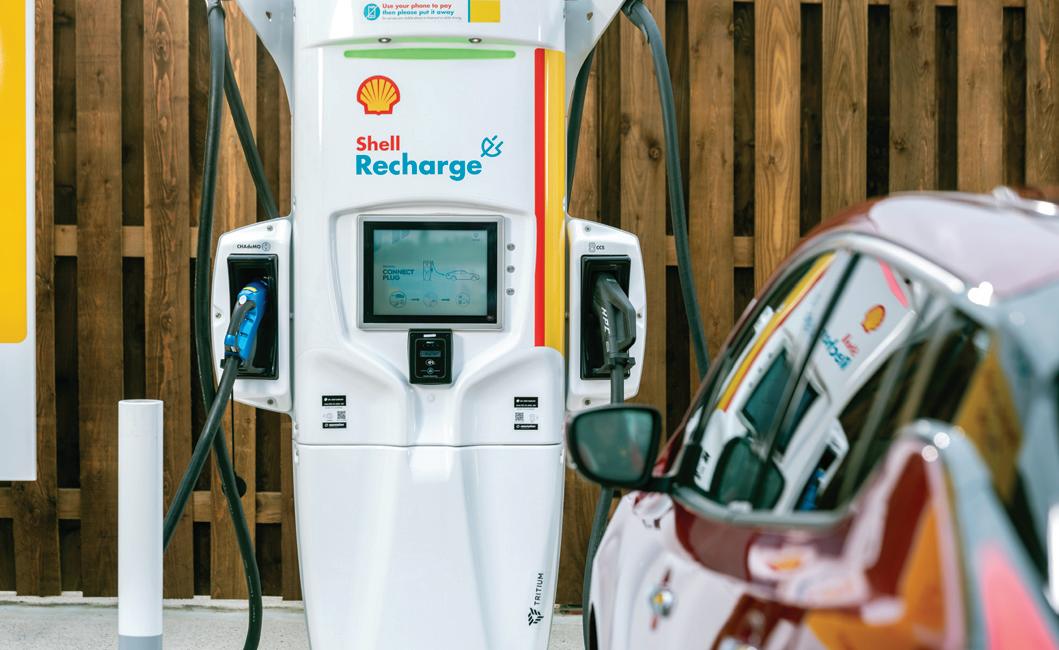
UKPC and Shell hope to extend this collaboration to include more of the 1,700 UKPC managed sites across the UK over the next five years, subject to take-up from car park owners.
Ben Cooke, chief executive at UKPC, said: “We are thrilled to announce our partnership with Shell. Our vision for the future of EV and its infrastructure aligns closely with that of Shell’s, and we both have a very keen focus on improving the motorist’s journey. This partnership further strengthens our position in the ‘mobility as a service’ market and supports our goals in providing a sustainable choice for charging across all of our destination locations.”
Electric vehicle chargepoint infrastructure is to be upgraded in the west London borough of Ealing. The on-street chargers will be owned and operated by Liberty Charge and delivered via its strategic partner Virgin Media 02.
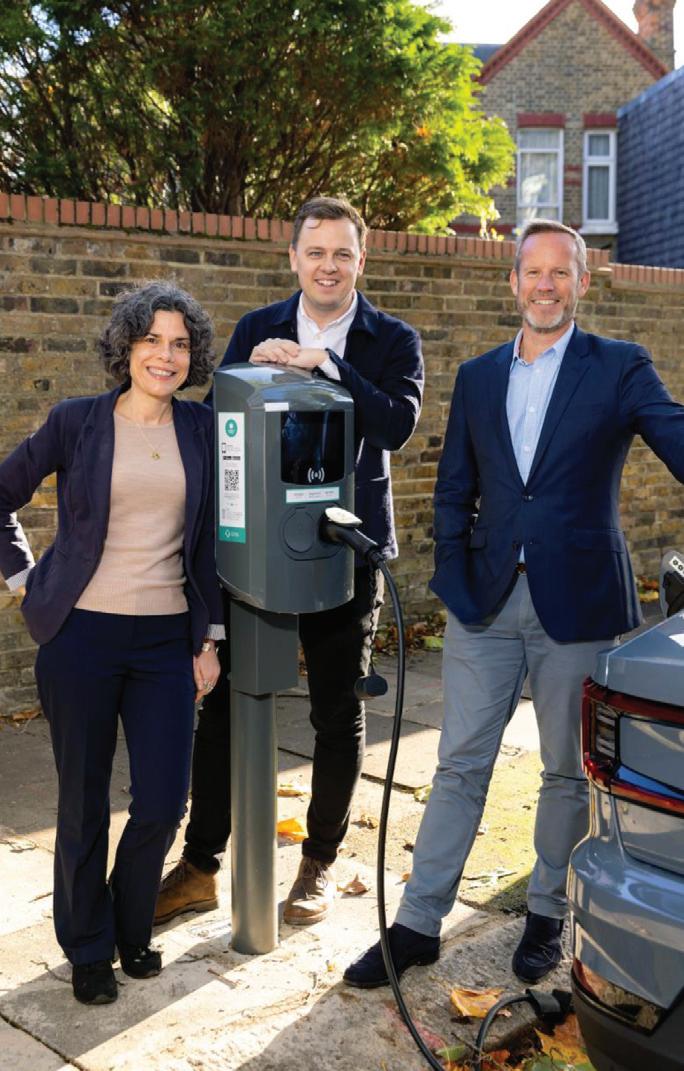
The installation of EV chargepoints (EVCPs) forms part of honouring Ealing Council’s commitment to improving air quality in the borough as well as creating accessible chargepoints for those without a driveway or home charging option.
The first tranche of chargers have been installed at 12 different sites, providing a total of 48 charging sockets.
The installations follow a high number of resident requests from Ealing’s EV drivers, eager to see more EV charging solutions close to their homes.
Cllr Peter Mason, leader of Ealing Council, said: “It was great to meet with Liberty Charge, celebrate our new partnership and get a first-hand look at one of our new charger sockets. This is just the beginning, we are committed to working together to boost the number of chargepoints across the borough as we strive to achieve net zero in carbon emissions for the borough by 2030.
“We want to rapidly expand the number of accessible EV chargepoints for those
without a driveway or home charging option. It is vital that local people are given a say in where these chargers are being installed which is why have a further 216 EV charging sockets due for consultation in early 2023.”
CllrDierdre Costigan, cabinet member
Customer Service Centre and dedicated maintenance and support teams.
“Compleo’s commitment to continuous development of charging technology and the support from the UK team make Compleo the perfect partner for our AC EV chargepoint network” said Kim Challis, regional managing director UK&I and group ESG director.
APCOA Parking UK has signed a multi-million pound deal with Compleo Charging Solutions UK to supply EV charging stations for its growing chargepoint network.
The deal will see Compleo UK deliver a further 1,000 AC charging stations by the end of 2024. It deepens the relationship between APCOA and Compleo after an initial partnership saw 451 AC chargers being installed across six Network Rail public car parks last year.

The expansion will also see APCOA extend its service offering in the EV market by providing 24/7 customer support via its National
“The APCOA Connect payment app puts accessibility and customer experience first and is integrated via API with the Compleo backend software, enabling EV drivers to park and charge in either one single payment or separate transactions.”
Valentin Scheltow, managing director of Compleo UK, said: “We are excited with our partnership with APCOA. The two organisations have in a short period of time made significant progress in the market. We are now actively working on our next project for a major NHS Trust and five different city centre car parks across the UK.”
for climate action said: “Switching to an electric vehicle could be great for your bank balance as well as the planet. Running costs are far lower than traditional cars, and electric vehicles are exempt from the congestion charge and ultra-low emission zone schemes.
“Our rapidly expanding network of EVCPs means all residents will be within 10 minutes’ walk from a charging point. More electric cars on local roads in place of petrol and diesel vehicles also means lower emissions and cleaner air.
“To support these aims, we are also rolling out a huge, £10m programme to support local people to choose active travel such as walking, cycling and scooting over shorter journeys by car. This includes everything from new cycle routes and bike storage, to improved surfaces for roads and paths, to our School Streets programme, which is making it easier for children to walk, scoot and cycle to and from the school gates.”
Liberty Charge says it can deliver chargepoint infrastructure at zero cost to local authorities, taking full responsibility for maintaining and operating the chargepoints without requiring any local taxpayer support. Neil Isaacson, chief executive, said: “Collaboration with the council and residents is paramount to securing the right chargers at the right speed in the right place – so the borough enjoys full EV charging optimisation.”
Two community venues in Swanley, Kent, have received funded electric vehicle chargepoints with support from UK Power Networks’ Green Recovery scheme.
The power network operator has extended the electricity network at The Olympic, in Beechenlea Lane and The Alexandra Suite, in St Mary’s Road. This has enabled the connection of eight chargepoints.
Opening the new chargers, Laura Trott MBE, MP for Sevenoaks and Swanley, said: “I am delighted Swanley has benefited from UK Power Networks’ £66m Green Recovery scheme, which is supporting government plans for a green industrial revolution. By fasttracking low carbon energy projects we are supporting the important drive to net zero carbon emissions and improving local air quality in the town for its residents.”
Ryan Hayman, chief executive of Swanley Town Council, said: “We are grateful to UK Power Networks for supporting this project through the Green Recovery scheme, enabling us
to install our first new EV chargepoints, helping visitors to our venues from far and wide.
“This project will help drive a reduction in emissions and marks an important step in improving local air quality in our community.”
Adam Lakey, who is leading the projects for UK Power Networks, said: “We are delighted to be working closely with local authorities, community groups, bus and motorway service operators to make it as easy as possible to connect more low carbon technologies to the network, supporting the low carbon transition.”
UK Power Networks is delivering £66m of ‘green recovery’ investment to support low carbon energy projects to achieve the government’s Ten Point Plan towards net zero by 2050. A total of 86 schemes are being fast-tracked by the electricity company across a range of sites including charging hubs at motorway service stations, fleets of electric buses, community energy schemes and heat pumps.
The Leading Independent Consultancy for all your parking solu琀ons Established in 1991, with over 230 sa琀s昀ed customers comprising both public and private sector (including Local Authority and Health and Educa琀on establishments). Quality parking solu琀ons provided by our experienced in house specialists:

GIS mapping and surveying
• MTO site surveys and digi琀sing.
• On street TRO signs and lines: legality and condi琀on surveys (sample surveys also available).
• GIS mapping of TRO surveys, produc琀on of digital maps and TRO management for Order wri琀ng, upda琀ng and consolida琀on.
• Data extrac琀on and conversion of text based schedules to digi琀sed map based solu琀ons.
• Length of stay, usage, and occupancy parking surveys, both on and o昀 street.

• Compliance surveys and data analysis.
• Surveying and mapping of infrastructure assets.
• Financial appraisal and e�ciency reviews of parking service provision.



• Collabora琀ve working – joint no琀ce processing and shared enforcement.
• On and O昀 street tra�c regula琀on order wri琀ng.
• DPE and CPE feasibility studies and implementa琀on.
• Tari昀 reviews.
• DPE/CPE services speci昀ca琀on wri琀ng and tender evalua琀on.

Contact: Peter Lowe B.Eng., C.Eng., M.I.C.E., FBPA Tel: 01492585055 or 07900264137 Email: plowe@rtaassociates.co.uk
RTA Associates Ltd www.rtaassociates.co.uk






















































































































